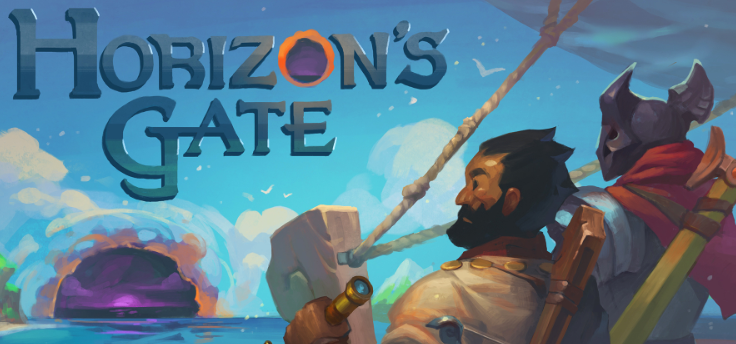Yar har, fiddle-dee-dee. Do what you want ‘cuz a pirate is free.
Type: Single-player
Genre: TRPG, Open-world,
Trading
Developer: Rad Codex
Publisher: Rad Codex
Release date: 9 Mar, 2020


Intro
When I was too young to play games for myself, my aunt had bought an NES, and one of the games I would watch her play was Uncharted Waters, and eventually when I had a PC, I could play its sequel, New Horizons. This set off a life-long love of the KOEI historical simulation games, which especially bloomed around the SNES era, although some genre staples like the storied Romance of the Three Kingdoms series still lives on. (Albeit in the shadow of its spin-off Dynasty Warriors cash cow…)
Developer Rad Codex, who previously made the Final Fantasy Tactics-esque Voidspire Tactics, seems pretty obviously inspired by some of the same things I was as a child, and Horizon’s Gate exists to fill that itch of a niche in gaming that has so long gone unfulfilled by anything other than the much more technically complex, yet exploration-poor Calypso games such as Rise of Venice or the newly-released Port Royale 4, and even there, I’ve found the series to be going on a downwards trend since the fantastic Patrician III, releasing more and more graphically updated but mechanically dumbed-down games with every iteration.
Horizon’s Gate, then, is a game ideally suited to my tastes at a time when I was really craving something new, but that doesn’t mean that even simple dabblers in trading games or tactics RPG purists will find themselves out in the cold. Horizon’s Gate as a mercantile game is less complex than even the newer Calypso games, while it’s open-world nature lets you choose what gameplay you immerse yourself in, to an extent.
Hybrid Genres
It’s frequently been noted that games that try to be a hybrid of genres tend to make a large number of shallow, uninteresting games rather than a single deep and interesting one. Rad Codex, however, made their hybrid genre game the smart way: They cleverly built a standard “Tactics” RPG in the same vein as Final Fantasy Tactics as two separate standalone games (Voidspire Tactics and Alvora Tactics), and then reuse all that work while stapling a new genre on top of the old game.
This tends to have the positive effect of the combat being robust and well-developed to the point that it could be its own standalone game (because it was), but at the same time, being good enough that some people want to only play the combat as a standalone game, and see the long stretches of exploration and trading as the boring bits between fights. Because many of the tactical combat areas tend to be small and require plenty of exploration to find, it’s hard to avoid the exploration and trading parts of the game, but easy to avoid the combat parts of the game. The only reliable way to get into tactical combat constantly is to either fish for monster den clearing guild jobs or just trawl Cleever waters for fights or otherwise go full pirate against a faction. You kind of need to be in the intersection in the Venn Diagram of people who want Age of Exploration trading game mechanics just occasionally punctuated by pirate battles when things get slow like I am to really get the most out of this game.
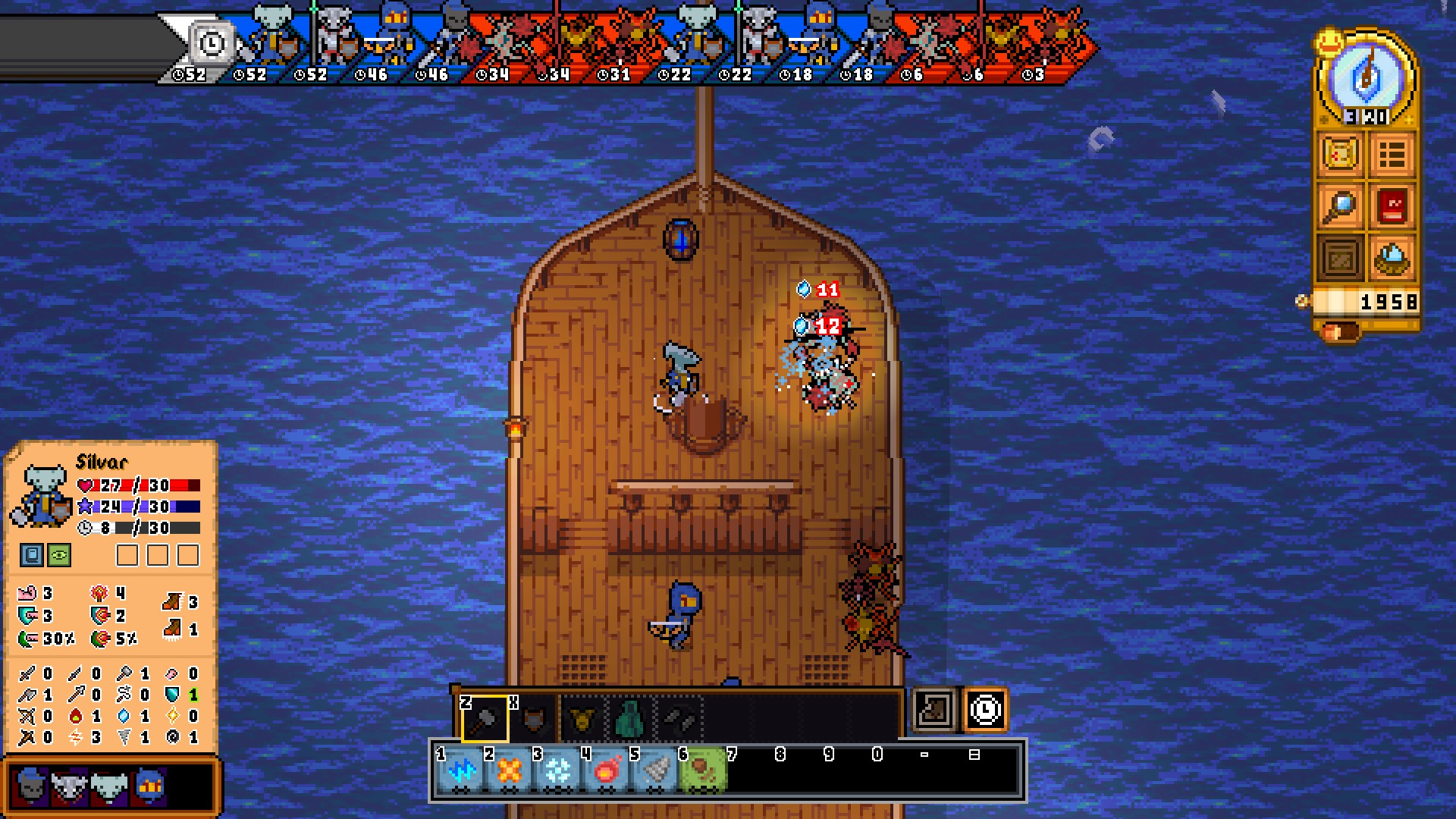
Character Creation
Rad Codex apparently took the lesson that you shouldn’t bore players with a long-winded monologue about your world’s history before they’ve gotten immersed in the game world and have the context for that history lesson to be interesting to them a little too much to heart. When you hit “New Game”, you’re dumped into a black background with a character creator that has limited sets of options for cosmetic changes to your character, but is mainly a race selection screen.
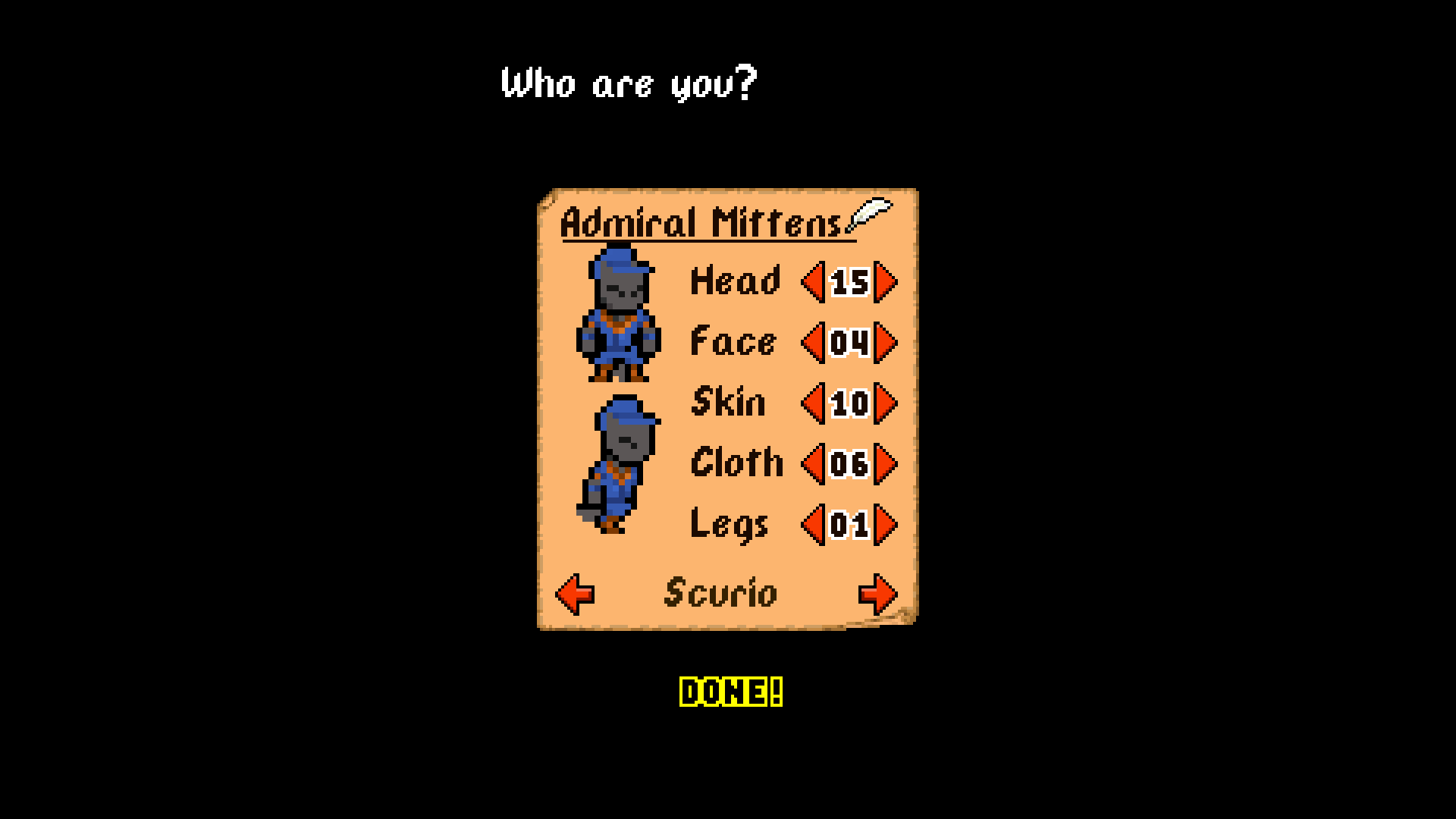
(Note that gender isn’t an option. Only major NPCs even seem to have genders, with your character and generics being at best differentiated by having eye lashes from a cosmetic character option.)
Races range from humans to your typical fantasy furries to four-eyed shark-people (I think? It’s hard to tell with pixel art like this) to faceless purple people to snake people with feathers for hair.
Still, who picks races based upon looks or RP in a CRPG, anyway?! Races get a wide range of possible bonuses, with boring ol’ humans just getting a measly +10% EXP boost, some races gaining a bonus to movement per turn or how many time units it takes to get a turn, to an armor bonus or magic resistance bonus, to a +10 MP that’s way more valuable that it sounds. The “Zyla” lizardfolk race are even covered in poison spines that poison melee attackers. Unless you’ve played a Rad Codex game before, there’s absolutely no way to judge the relative value of these bonuses, and some of these bonuses are vastly more valuable than others, so considering the amount of time investment a player can drop on a single game, telling them to just play and restart with a New Game+ to make a decision that’s actually informed is a negative point against this game.
It’s also worth noting that you can alter your own character or any generic crew member’s name and cosmetic features (but not race) during play, and that clothing is determined by character class (with color determined by armor type).
Open Seas
After the intro sequence, the game points you to your first open port and tells you to get a real ship with your cash on hand, not the intro sailboat. The game also suggests you join one of the three factions available to you because gaining rank and favor with them gets you significant benefits and with enough favor, you can simply pay your faction to fight the end game ship battle for you if you suck at that stuff. Beyond that, it’s open seas, for good or ill.
Sailing is performed either by punching movement keys in the direction to sail or right-clicking in a given direction. In keeping with the turn-based nature of the game, if you stop your ship, the world stops. Taps send you one tile, and make all ships in the area move exactly one tile as well, negating any speed advantages, while holding down will gradually let you pick up speed (with a rustling canvass sound indicating you’ve fully caught the wind and go at full speed to encourage going full sails ahead rather than being tile-perfect).
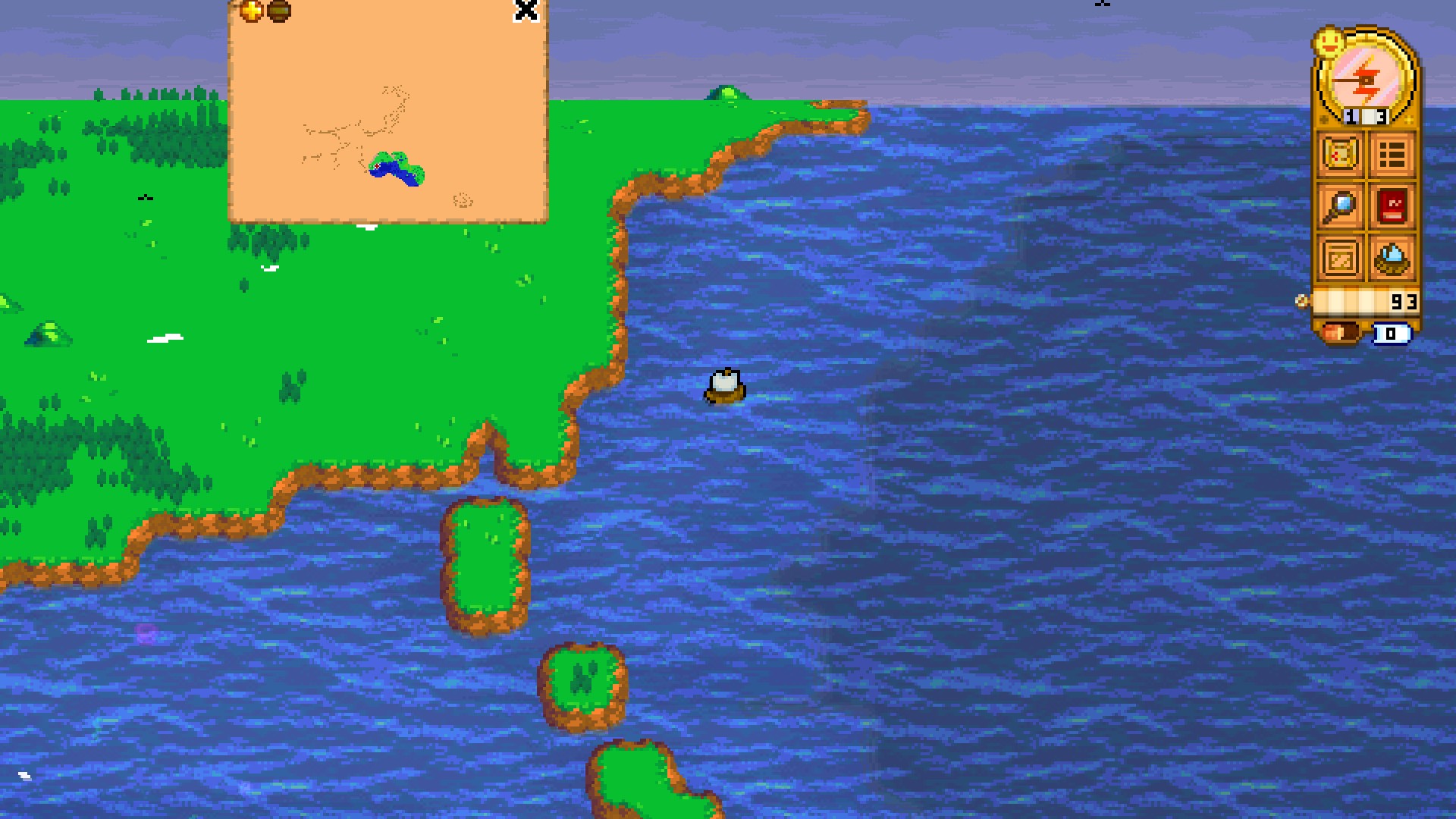
Rather than a “buy low, sell high” mentality, the game is based around a “buy whatever, sell far away” mentality. Every port has exactly one specialty product with a set price that never changes. The value of a good is based purely upon the as-the-crow-flies distance from the nearest port that makes that specialty. This means that early on, you can just buy as much as you can afford/carry and sell one or two ports down the way, but as your fleet gets more and bigger ships, you quickly deplete the market. This is because some goods are expensive, like gold bullion and pearls, but those are only made in very limited quantities, while cheap goods like grain and glass beads are very plentiful but require massive cargo holds to make a profit. Regardless, the best way to make the big money is to buy lots of goods and ship them a long way to the most far-flung ports, which are usually in the corners of the world. (The world map doesn’t wrap around, there’s just an invisible barrier off the edges.)
While there are menu buttons on the top right at all times, the display is relatively minimal. Compared to Uncharted Waters, wind is displayed purely by swirls of white… clouds(?) floating in the air, there is no windspeed indicator (or wind speed at all), and no currents to track at all.
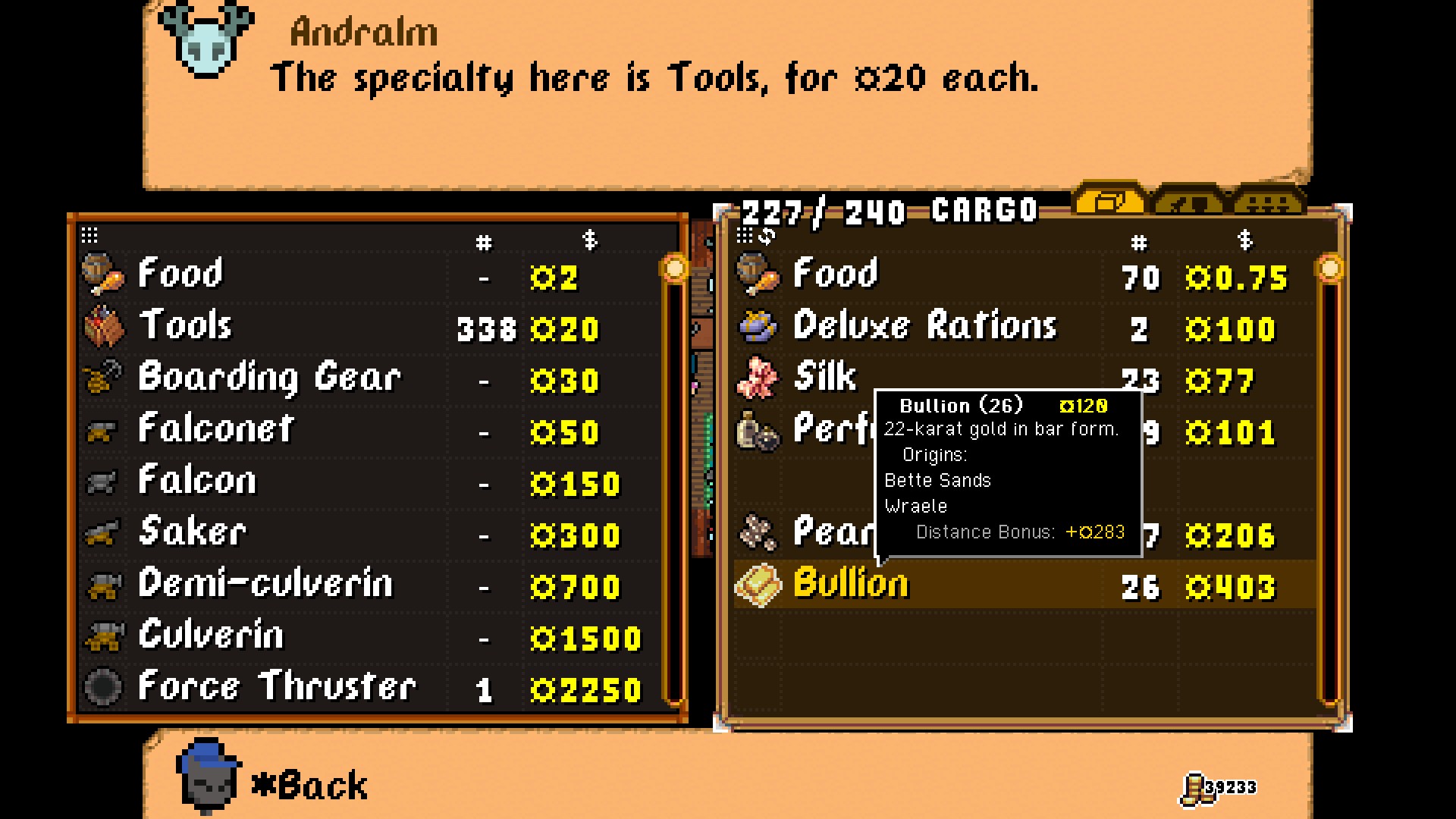
Typically, this means buying all the goods (and late-game, I do mean all the gold and pearls in the world) only produced in the south or eastern edges of the world, and selling them in the northwest corner after a journey of two or three months for profits of tens of thousands of gold before scouring the world of products in the west and southern regions to sell to the northeast.
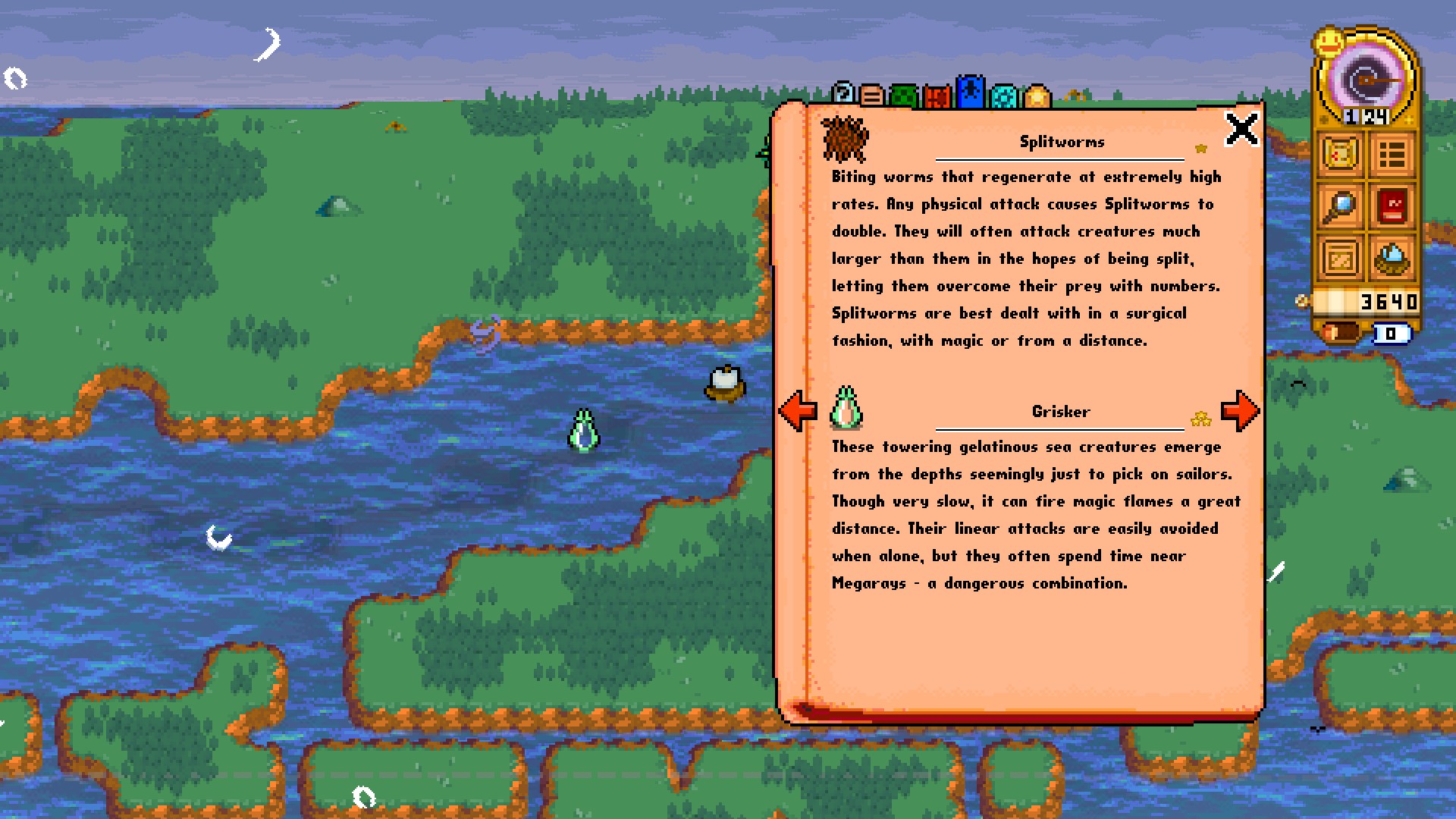
Exploration often consists of using the “Look” action on absolutely everything at least once. It’s kind of absurd how many things have journal entries, even down to tables and rugs. To incentivize filling that journal, the game has collectors who pay you for every journal entry. Yes, you get paid to “look” at things, even common things. Collectors even pay you for discovering things literally in the same room as them, such as “discovering” the rug they are standing on or the book they were reading. Many of the best-paying items are rare things found in groves that are hidden points of interest, but every town also tends to have at least one painting somewhere that counts as a unique journal entry for you to remember to “look” at.
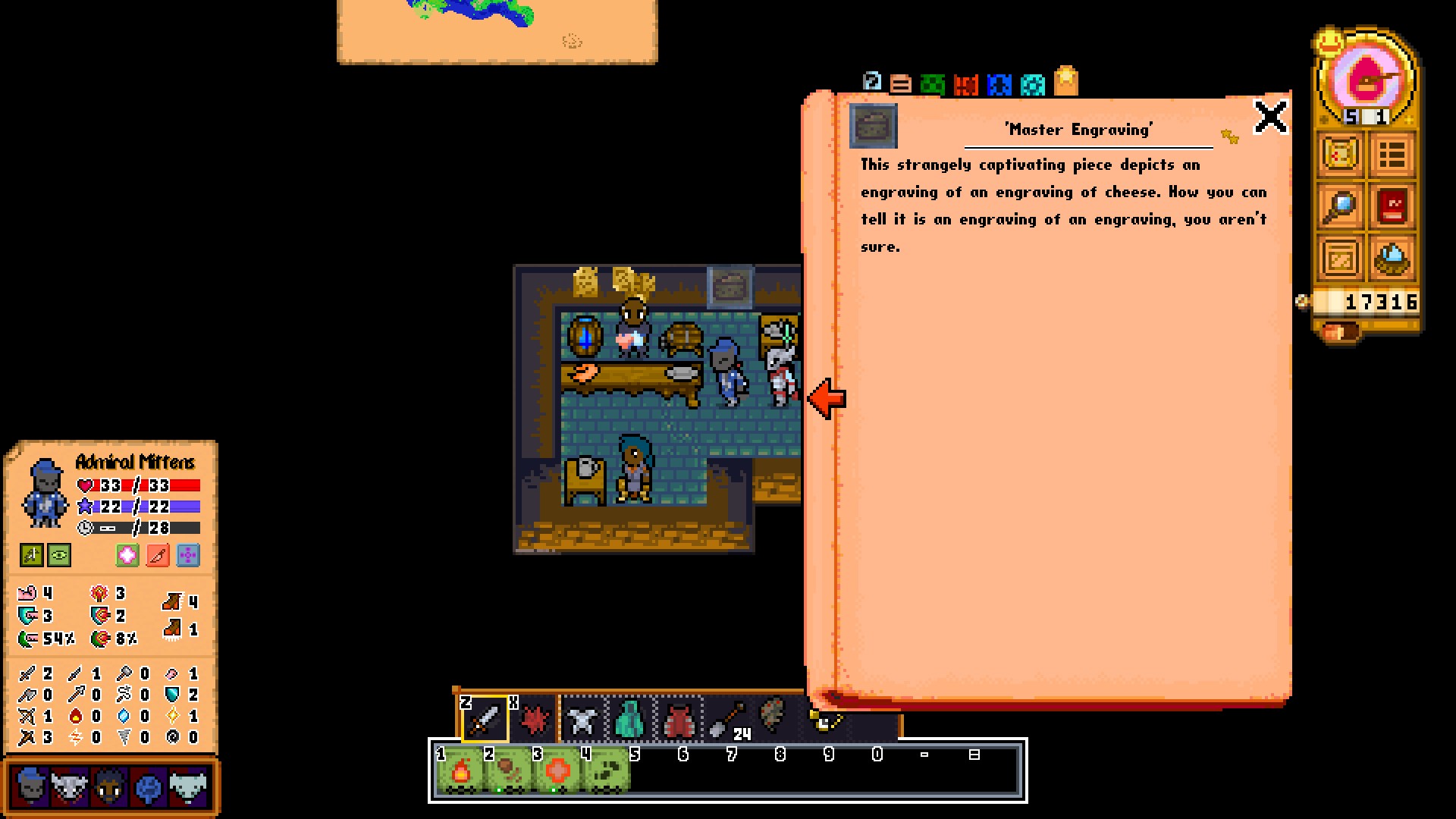
The same applies to mapping the world – the “world” map seems to just be a single continent (which is why you don’t wrap around to the west end when going off the east end of the map), although there isn’t much context about the game’s world to conclusively say so. (That said, there’s also an Equator and Prime Meridian, yet for some reason, only the north gets cold or has ice, and going even far south of the equator it still only gets more hot climates like deserts…) Regardless, the general area of the center of the map contains the “Great Sea”, the analogue for the Mediterranean in this world, although it runs north-south with the passage to the general sea being in the south. The three available factions are basically along a line south-to-north, as well, although Jascias is up a river to the west of the Great Sea itself.
Rivers in this game are easily navigable regardless of ship size, and there are no rapids or waterfalls. (Even the Nile is only navigable up to what used to be a waterfall and is now a dam.) Sailing into the wind requires no tacking, it just slows you down.
In an attempt to spice things up, the game has guilds that give out missions you can take while you’re out and about. These are procedurally generated content, but they’re a bit of an afterthought. They can request things like delivering a letter for trivial pay to asking you to bring back a specific type of cargo for much more than it’s actually worth (and can actually be cargo you already have in your hold – I once had three quests in a row requesting cargo I had immediately on hand).
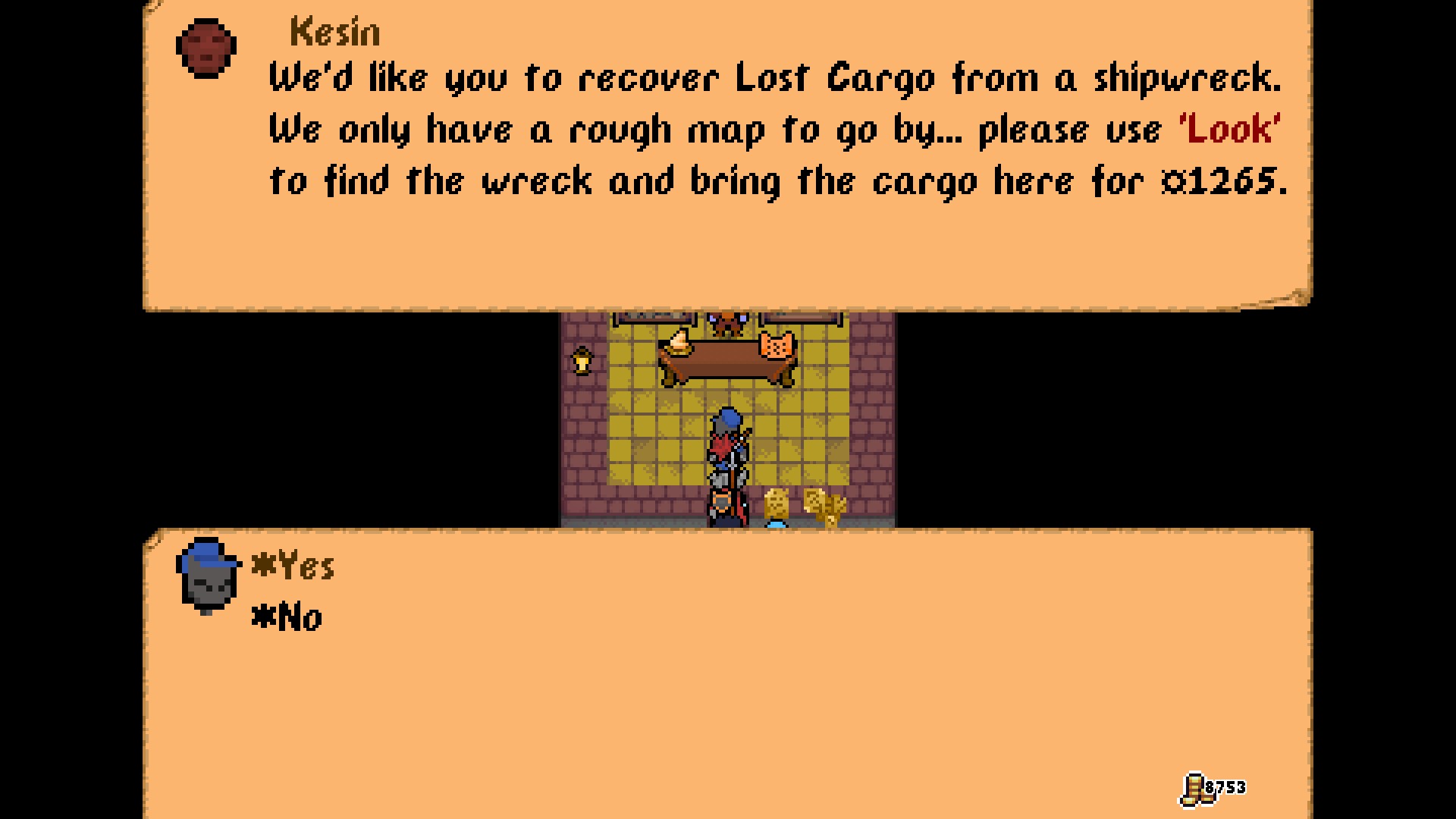
Pledging to a faction grants benefits like a trivial discount you can gain on food and repairs, with aligned ports, but the real benefit is gaining access to unique faction ships. I wound up pledging with Jascias, the faction of the God-Emperor Jasce purely on the basis of the fact that they had the fast ship, the Blackwing Galleas. The other factions get the slow but durable Ironclad or the even slower and even more durable Glacier, which is a literal iceberg with cannons. The way to gain rank is to gain “fame”, which is sorted into exploration fame (from finding new landmarks and “look”ing at stuff to fill your journal), mercantile fame gained by literally any trading, and combat fame from combat. Notably, I easily gained triple as much exploration and mercantile fame as combat fame even when I was overtly trawling for combat, although I didn’t go so far as to actively pirate other factions, as I didn’t want to overtly create enemies while I was making the bulk of my money from trade.
Once you join a faction, you’re not entirely in for life, but trying to defect to another faction makes your old faction loathe you (-99 favor, they bar you from ports and will attack you) and it costs more money the higher in rank you are when you defect.
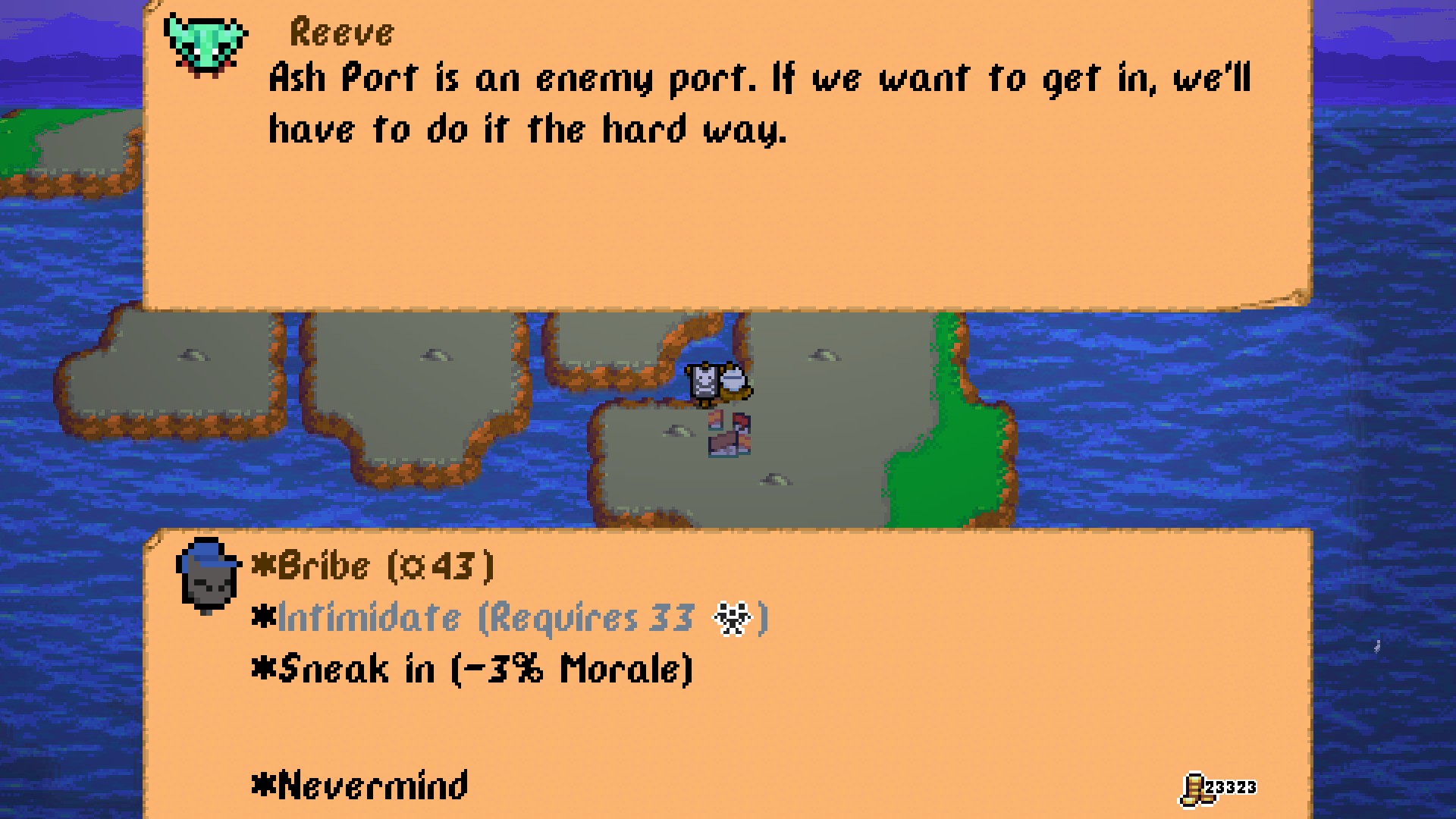
The most common way of gaining favor with your faction is to invest money into ports. Investing is obviously very expensive, but it causes ports to be able to produce more of their specialty product (hypothetically making you more money in the long run), as well as making new products like ships or equipment available.
Finally, as I was playing the game for review, an update came along that added purchasing supply ports for yourself and upgrading them over time. Hypothetically, you can do this for a profit, but you get 6 gp per day in return for building a building that costs 10,000 gp to build, so I’ll be looking foward to that trickle of returns five game years from now when I made the money to build that building in less than a month.
The main reasons to splurge the tens of thousands of gp on your own home port, however, is to have access to features like smithies far away from the Great Sea where most of them are located, and to have lots of customization options. You can recolor the houses but not the land around it, so if you pick a gloomy supply port, it will remain gloomy even with you plopping a brightly-colored house in it, and choose where in the specified lots you place each individual house or shop.
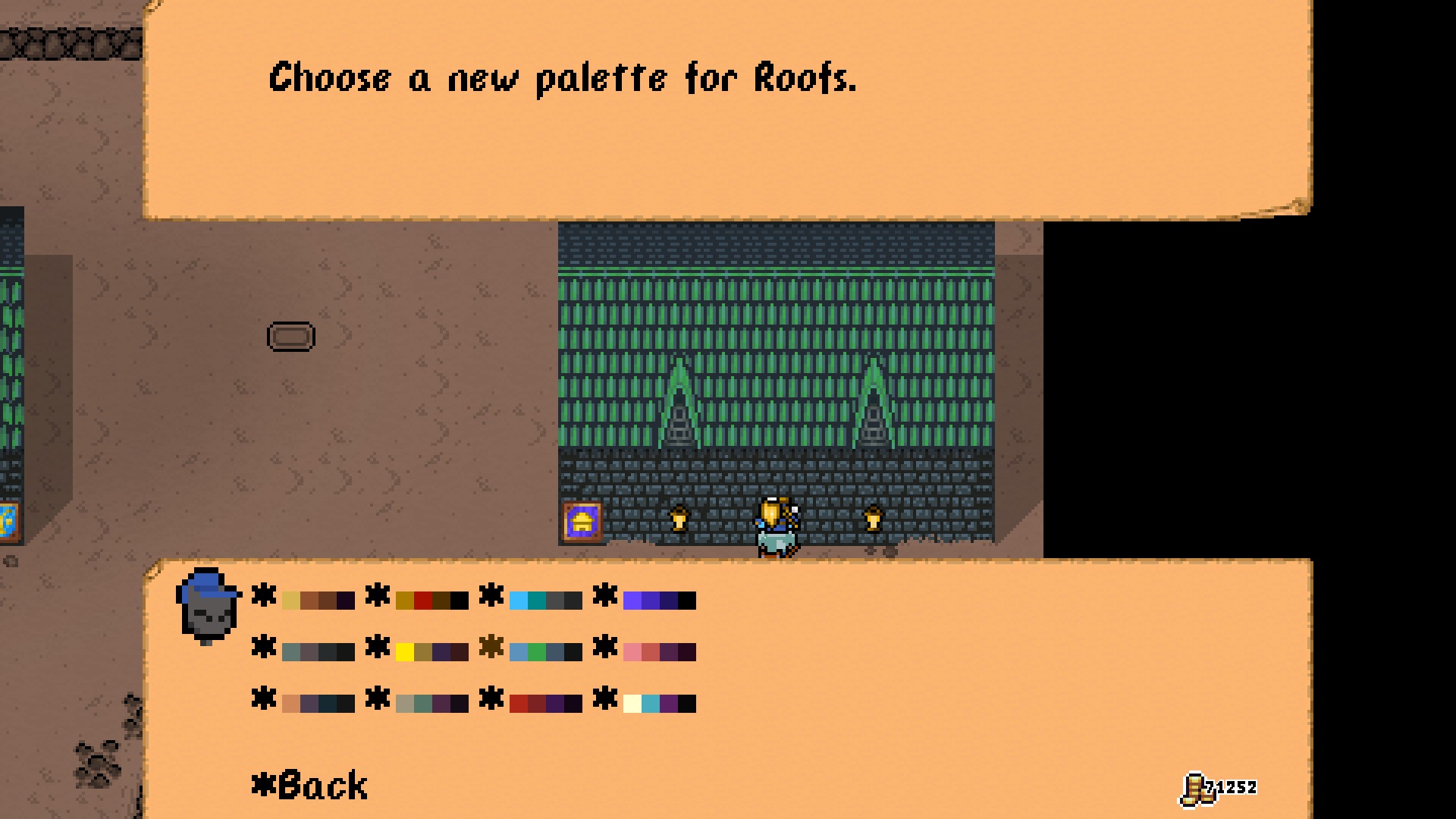
On Ships
In most naval games, you’ll have an abstract number of crewmen that is very roughly historically accurate to a given class of ship. (Note that ship classes during this era were very broad, and a “caravel” could be anywhere from 50 to 160 tons displacement, have one to three masts, and have a crew of 10 to 150 men, depending on who made it for what purpose.) When you go from the lightest ships, like sloops, they tend to have something like a minimum crew of 8 men to larger ships that have a minimum crew of 60 men and a maximum of 300.
Horizon’s Gate, meanwhile, expects the whole crew to get involved in a tactical RPG combat during boarding, so a small ship has a minimum crew of 2, and even the largest ships have a minimum crew of 6, with all ships having a similar maximum of 8 participants in combat, but no seeming upper limit in passengers.
To underline the differences in the sizes of craft, ships of different size categories tend to be priced an order of magnitude apart. Cogs are the small/starter trading vessels worth 600 gp with 3 crew for 40 cargo space, while the carrack is 5,200 gp and 4 crew for 100 cargo space, and the barge is 18,000 gp and 5 crew for 180 cargo space. All three of these have 3 movement, but the windjammer for 48,000 gp has 4 movement and 5 crew for 140 cargo space.
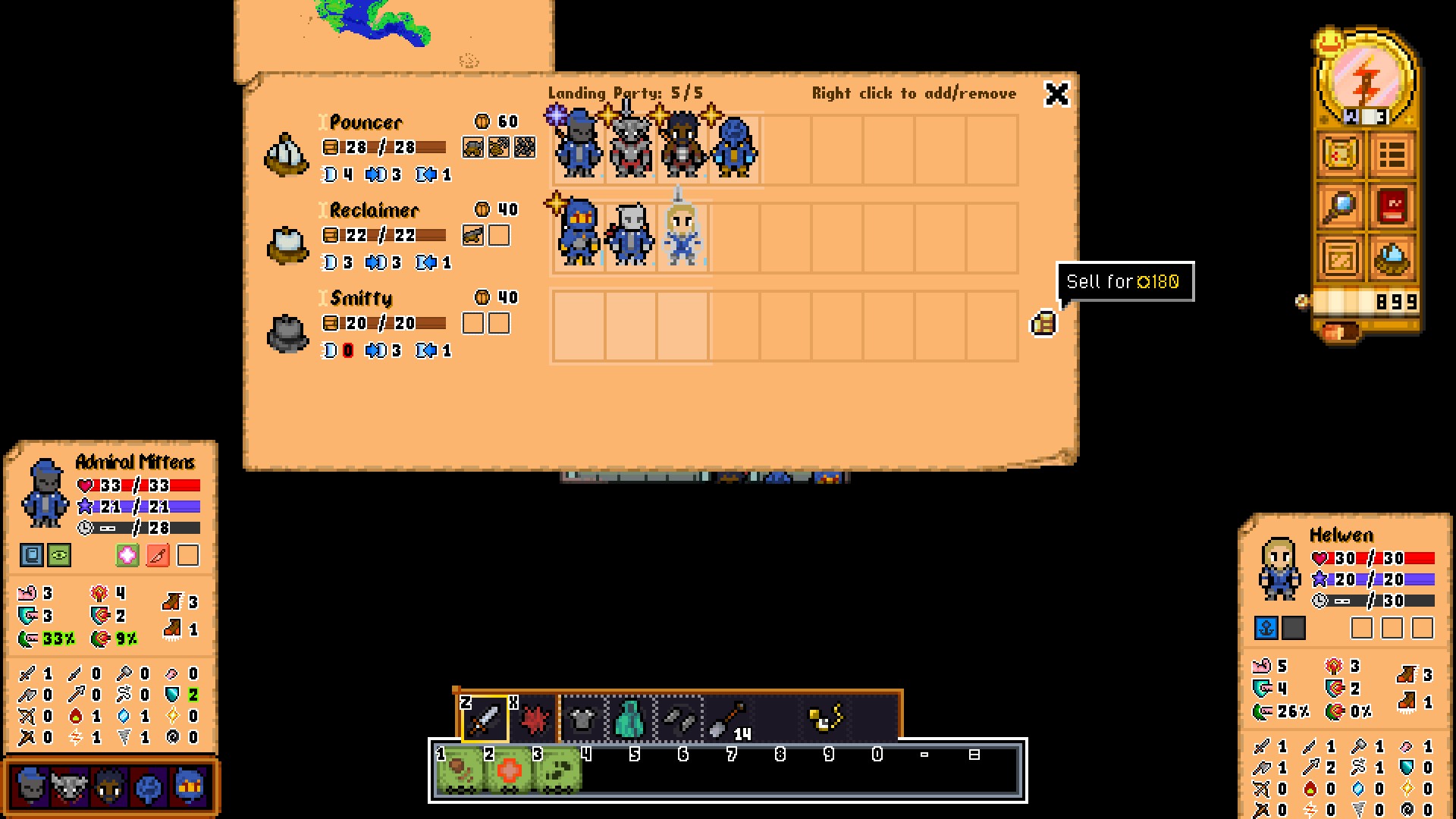
Note that for trading, your costs are largely based upon your crew. You need to feed 1 cargo space’s worth of food per day per crew member, and if you don’t have a full fleet with at least 4 movement, you will probably want at least 7 days of food. Hence, a cog is a worse deal than it looks on paper, because 7 days of food for 3 crew is 21 of your storage just for food, leaving only 19 cargo space for actual cargo, while the carrack has 28 cargo capacity taken up by food for 72 free cargo space, and the barge leaves 145 space free. (Or 6.7 storage per crew member for a cog, 18 storage per crew member for carracks, and 29 storage per crew member on a barge.) While food itself is cheap (3 gp per crew member per day), to keep morale up in this game, you need to buy your crew drinks while on shore leave, and the local specialties can be wildly variable in price and effect, and the cost is multiplied by number of crew members. Having lots of cogs can be cheaper in upfront costs, but 600 gp is a spit in the ocean compared to your operating costs even a couple months in.
It can wind up being easier to win naval battles by stocking up on ships you don’t mind letting sink as well (mostly pinnaces), but every crew member is a character that has stats and needs to be trained, which can generally only be done en masse with lots of boarding combat, which is a massive time sink. Also, you can only get one or two crew members per port per visit unless you’ve invested enough for at most three.
Naval Combat
When two fleets find they are disagreeable and are within two tiles, combat can begin. The player can also become a pirate and attack non-hostile ships, as well.
Naval Combat involves taking turns with the first ranked ship in your roster getting a move, then the second, etc. until all your ships move, and the other side gets their go. Each ship has a movement rating, and can move that many tiles (orthogonally, even if you have diagonal facings – pointing southwest just means you can only move west or south in your next movement, and points you in that direction). This means that slow merchant ships are a liability in combat, and even heavy combat ships have trouble, but because all ships have the same amount of “handling” per unit of speed, any ship can pull a 180 in 4 tiles, and after you end a turn without firing cannons, you can further turn 45 degrees at the end of that turn.
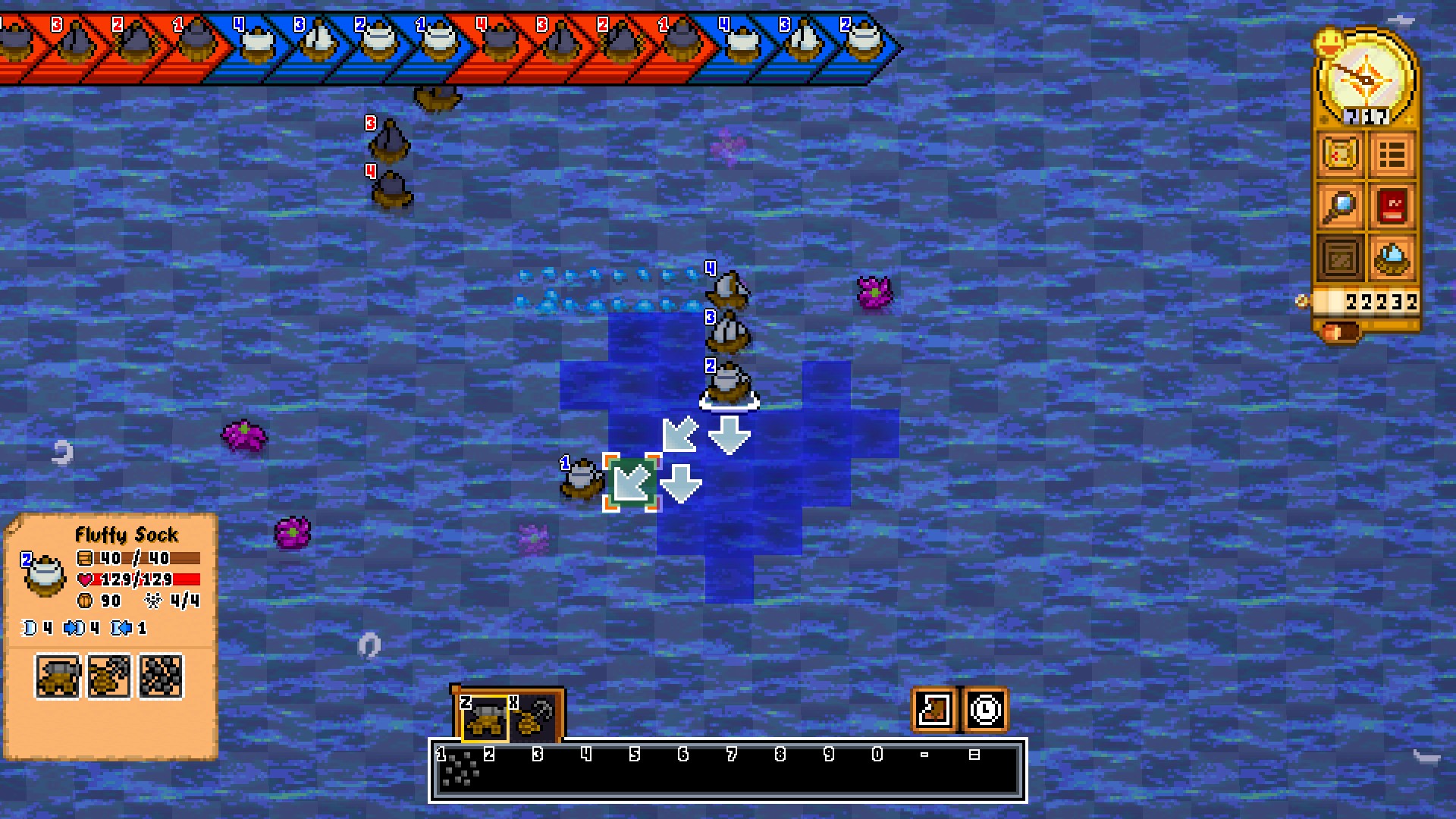
Cannons are loaded into cannon slots, which are set by the class of ship you have. These cannons are an anachronism stew with a further sprinkling of fantasy weapons like lightning guns. Historically, bronze culverins were the big guns of the Age of Exploration because metallurgical techniques could only produce crude cast iron cannons that were liable to explode if given significant charges. Hence, early “cannons” (which back then only referred to iron guns of a certain size) had half the powder of a culverin and therefore less range and penetration. You also put the big culverins on the bottom deck because they were heavy, and lighter cannons like sakers on the upper decks where they made your ship less top-heavy and liable to capsize. In this game, sakers are cheaper, inferior versions of culverins, and cannons are a separate class of better guns than even culverins that are a reward for investing in a port. At the same time, there’s a “Long Nine” that exists as a forward-firing gun, which refers to a nine-pounder, which comes from the centuries-later standardization of (then-always) iron cannons by shot weight. The long nine is somehow inferior to the relatively archaic culverins and “cannons”, and even features an “upgraded” version, the “Long Ten”. (They didn’t actually make that weight, though – but they did make long eights, so why not set it as long eights and then reveal long nines? Then again, this game has ice cannons that create icebergs, so screw it.)
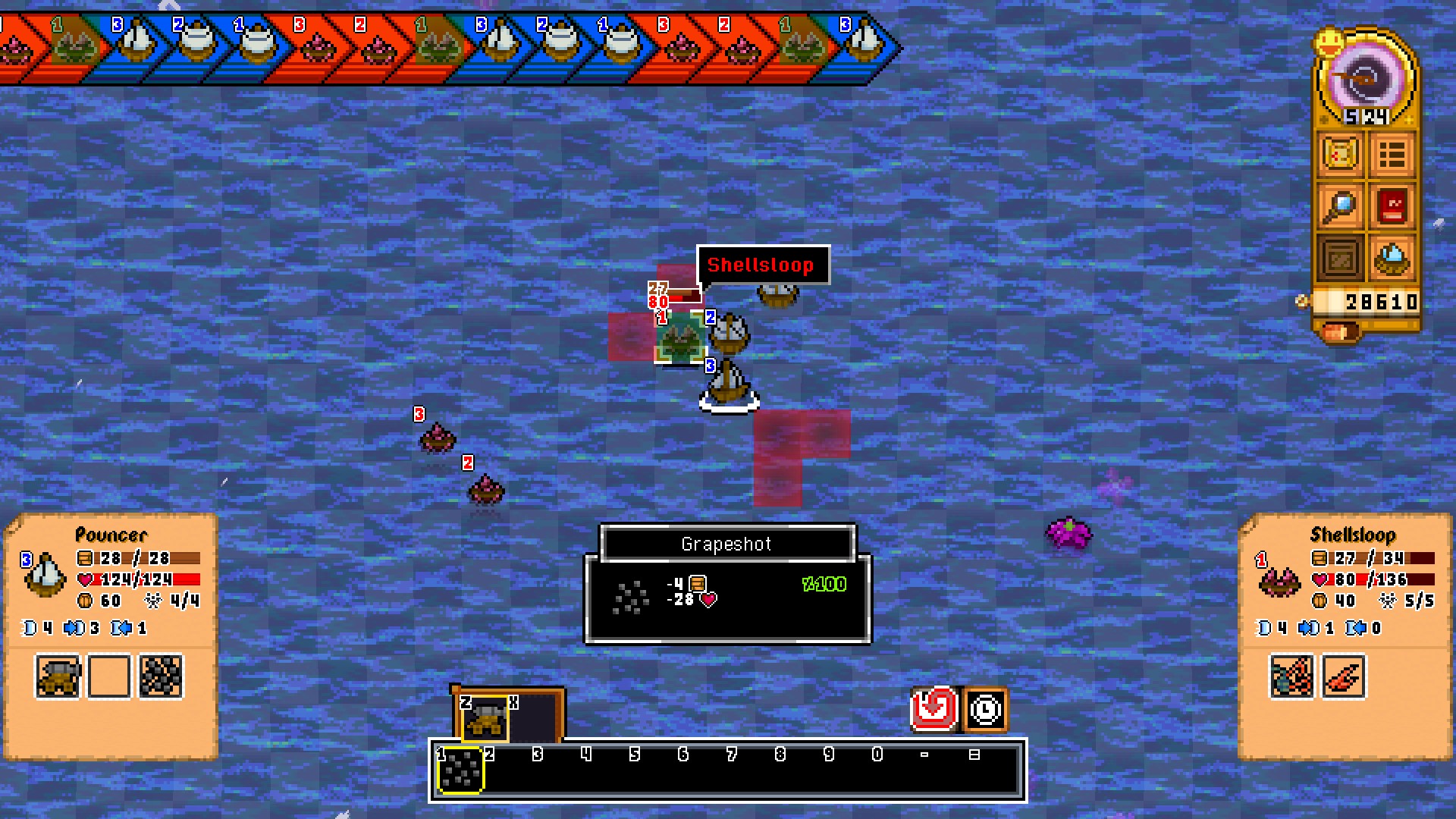
Cannons also deal more damage based upon range, with point-blank shots dealing to up 50% more damage, while ships that have more (healthy) crew also deal more damage with cannon fire.
Due to the way that ships are very agile, except against sea monsters that have oddball movement or attack types, it’s very difficult to win decisive one-sided victories where you shoot the enemy and then swing away before taking much return fire, at least without having overwhelming disparity in strength. (Unlike the easily-cheesed Calypso naval combat where I can destroy whole navies with a single sloop…) A ship that move even two tiles can turn 90 degrees, so only ending a turn directly up their stern in tight quarters will save a ship from return fire. Likewise, the AI is smart enough (except for sea monsters) not to split its fleet if you hang back unless you offer up a sacrificial ship as bait.
You can board enemy ships with boarding equipment if you get immediately adjacent to an enemy ship, which starts tactical combat (see below) for a limited number of time units. This tends to be about 2-3 rounds of actual combat, with a first round being spent just getting closer to the opponents. Your own ships can be boarded by an enemy that is healthy enough, and if you defeat boarders, you also take their ship.
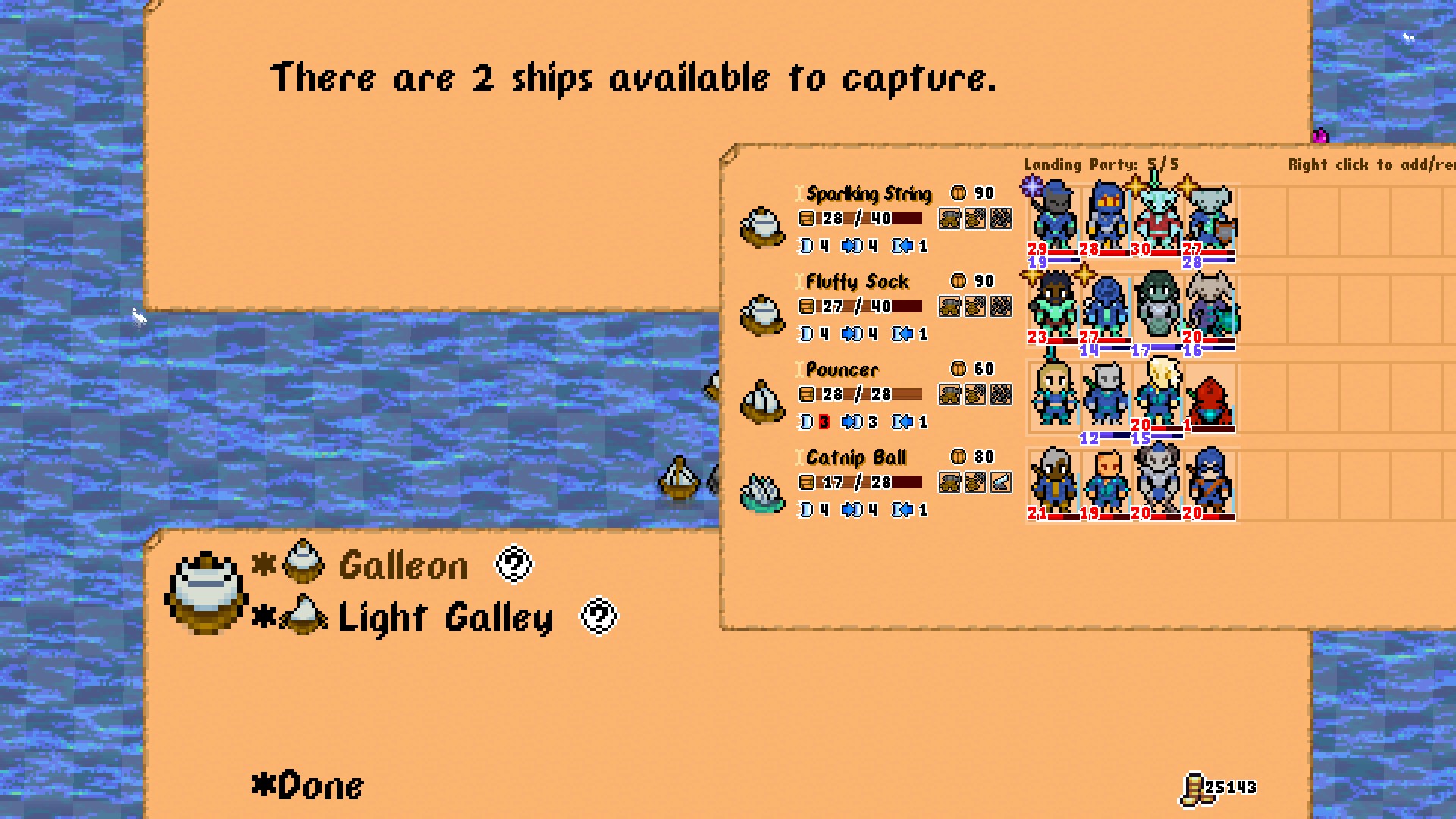
Ships you board and whose crews you defeat can be claimed and sold or used. Captured ships have a permanent -2 hull to lightly discourage just pirating all your ships. This makes profiting off of stealing higher-ranking ships much harder, as you generally face a net loss if you lose even a single of your own ships unless it was a throwaway pinnace.
There’s a TRPG in My Sailing Game!
The combat system is, as previously mentioned, simply reusing the code from two previous standalone games released five and three years prior. The result of this is that many of the aspects of combat have nothing to do with the sailing aspects. The combat portion of the game is designed with a party of five crew members going on away missions, although you can have larger parties than you can get on land if you are fighting boarding battles at sea. Many of the rules are therefore built around the idea of having five party members fighting land battles all the time, and most rules in the naval section have nothing to do with your character races or classes, at least until boarding.
Tactical combat can come about in a variety of ways: You can just have the aforementioned boarding combat, but you can also have combat in ports if you go to the arena or dojos or in a few certain sidequests that ask you to clear out the mines of monsters in a mining town, for example. Then, there are the groves that you can randomly find through exploration that have a single difficult battle and a reward behind it, monster dens that are repeatable procedural combat encounters you can get from the guild, and the rare few points of interest that offer larger maps. The developer has written that Horizon’s Gate has more hand-made content than Voidspire Tactics, but since it’s spread out across the whole world and needs to be found by hugging every coast, it feels like you’re not finding that much of it.
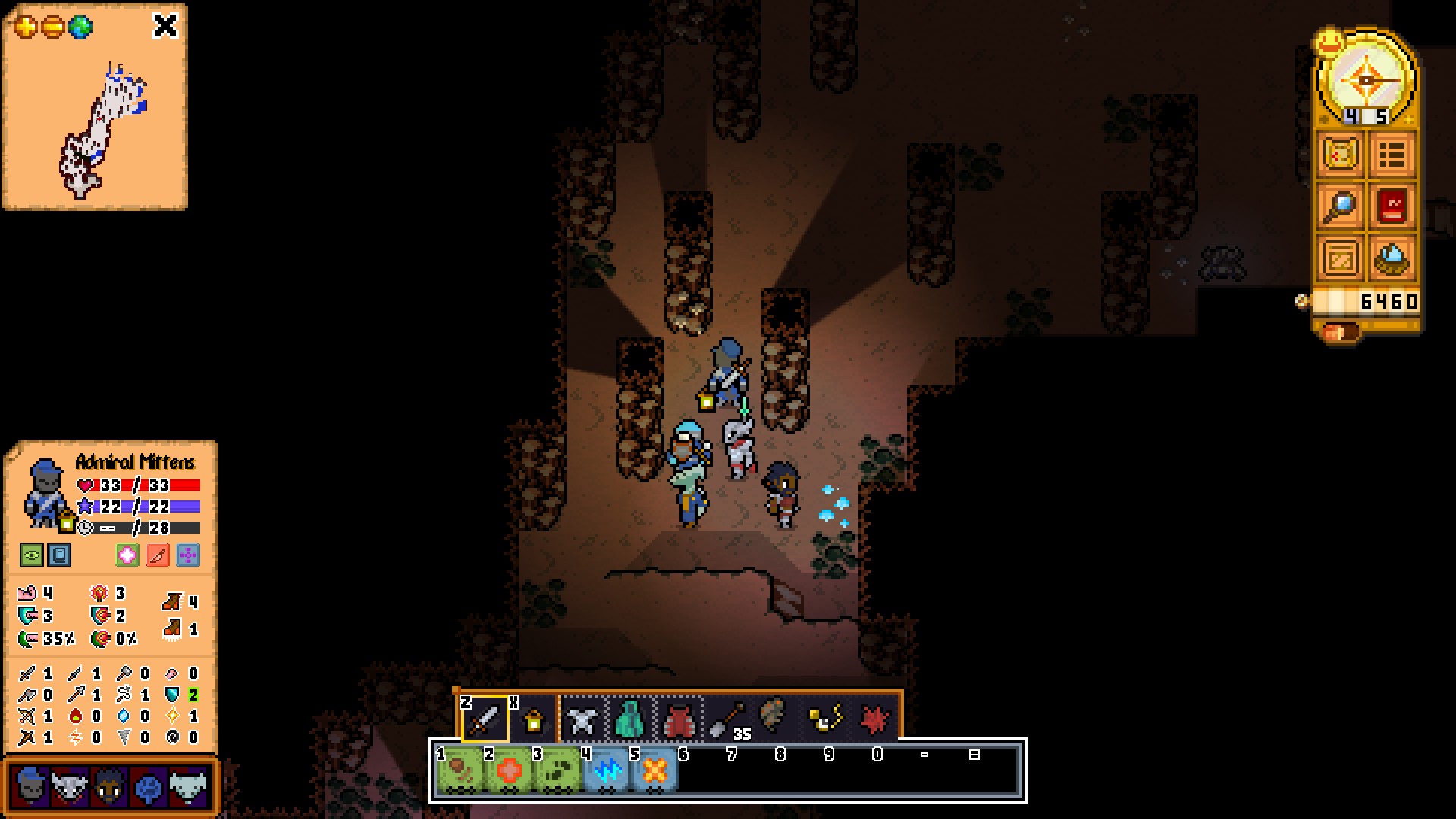
Combat tends to be short and brutal in this game, with the starting basic attack managing to deal about a quarter of an enemy’s health at first, and as you get through the game, you can get up to two-shotting or even one-shotting enemies. Mages dropping AoEs on the same targets can wipe out enemy groups quickly. That said, in more difficult areas, you can be overwhelmed by alarmingly large numbers of enemies.
The game also has no rubber-banding. The Great Sea area tends to be the “newbie zone”, so it has easier dungeons, but beyond that, it’s a crapshoot how difficult any given location will be.
To add the actual tactics to this tactics game, however, Horizon’s Gate adds a lot of interesting abilities based upon the terrain and pushing units into hazardous terrain.
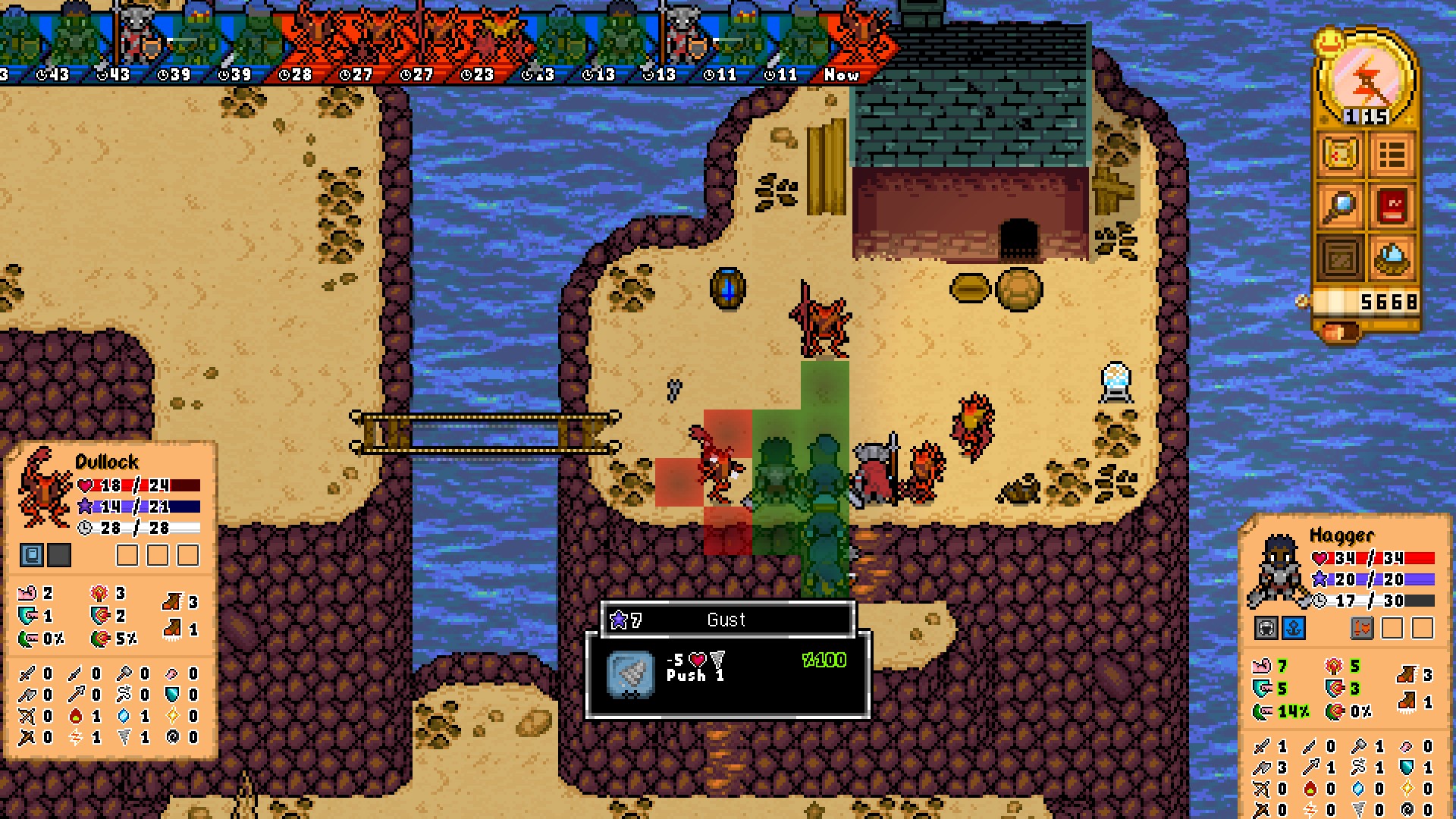
The game is also filled with many “secrets” of various sorts that come from interacting with the environment in certain ways. The second town you are likely to visit has “lattice weed”, which is a naturally-growing ivy-like plant that can form an effective ladder. You can pick seeds from the plants that have grown there, then place them further up cliffs, and cast the sage spell “growth” (which normally is a regeneration spell) to make the seeds grow into a climbable path, allowing access to new areas. You can buy sheers in stores, and use them to cut leaves into bandages, then soak the bandage in oil to make it an oily rag, then put it in a bottle full of oil to make a molatov cocktail to throw for an AoE burning attack.
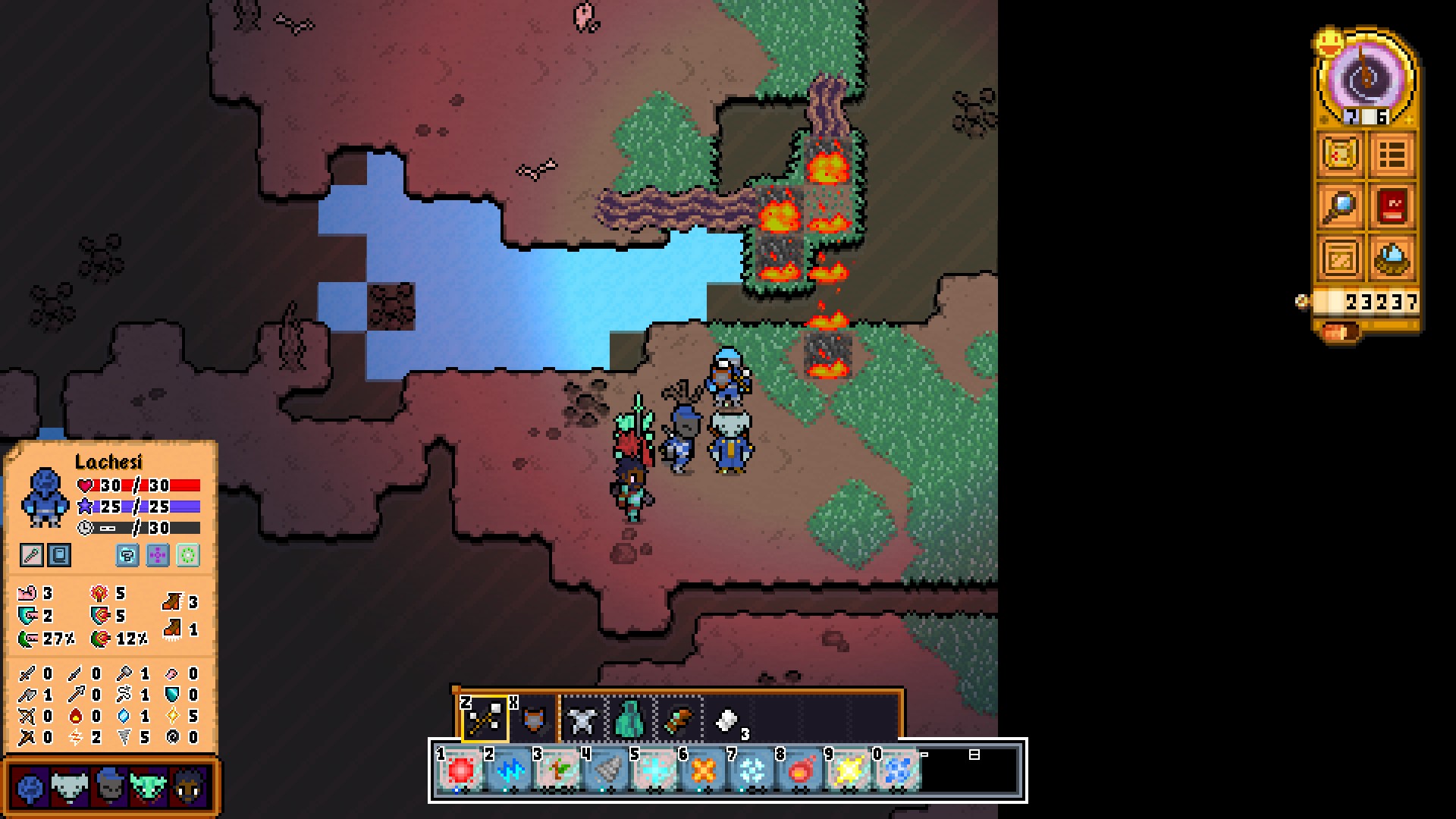
Enemies also have a range of sight, which you can abuse (you can even see their sight cones with a Rogue passive skill) by setting up terrain effects while standing outside their activation zone. When I saw a powerful enemy, I used my bombardier skills to throw down bombs, then used wind magic from my scholar to blow the bombs towards the enemies before detonating them to really start combat off with a bang.
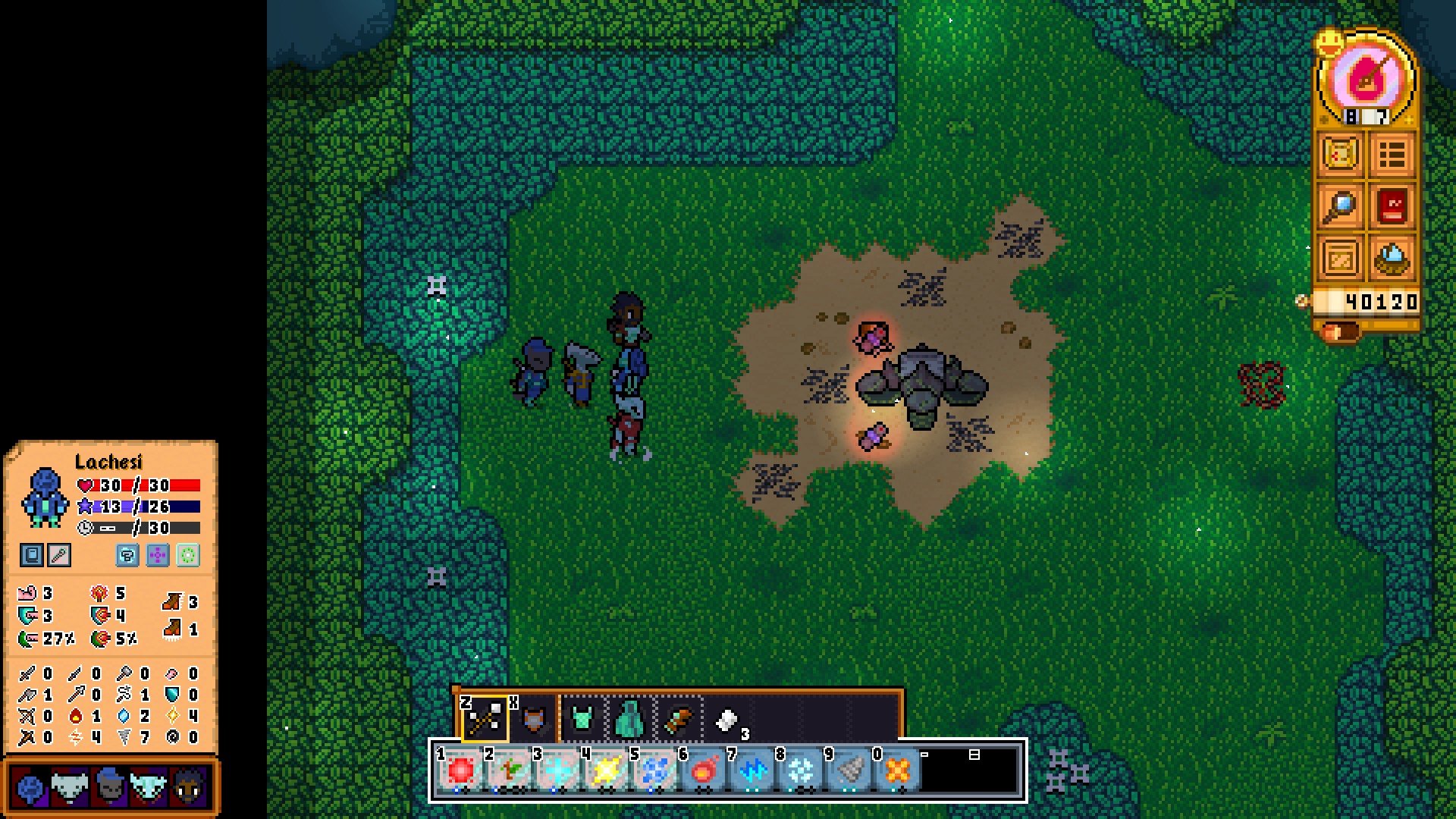
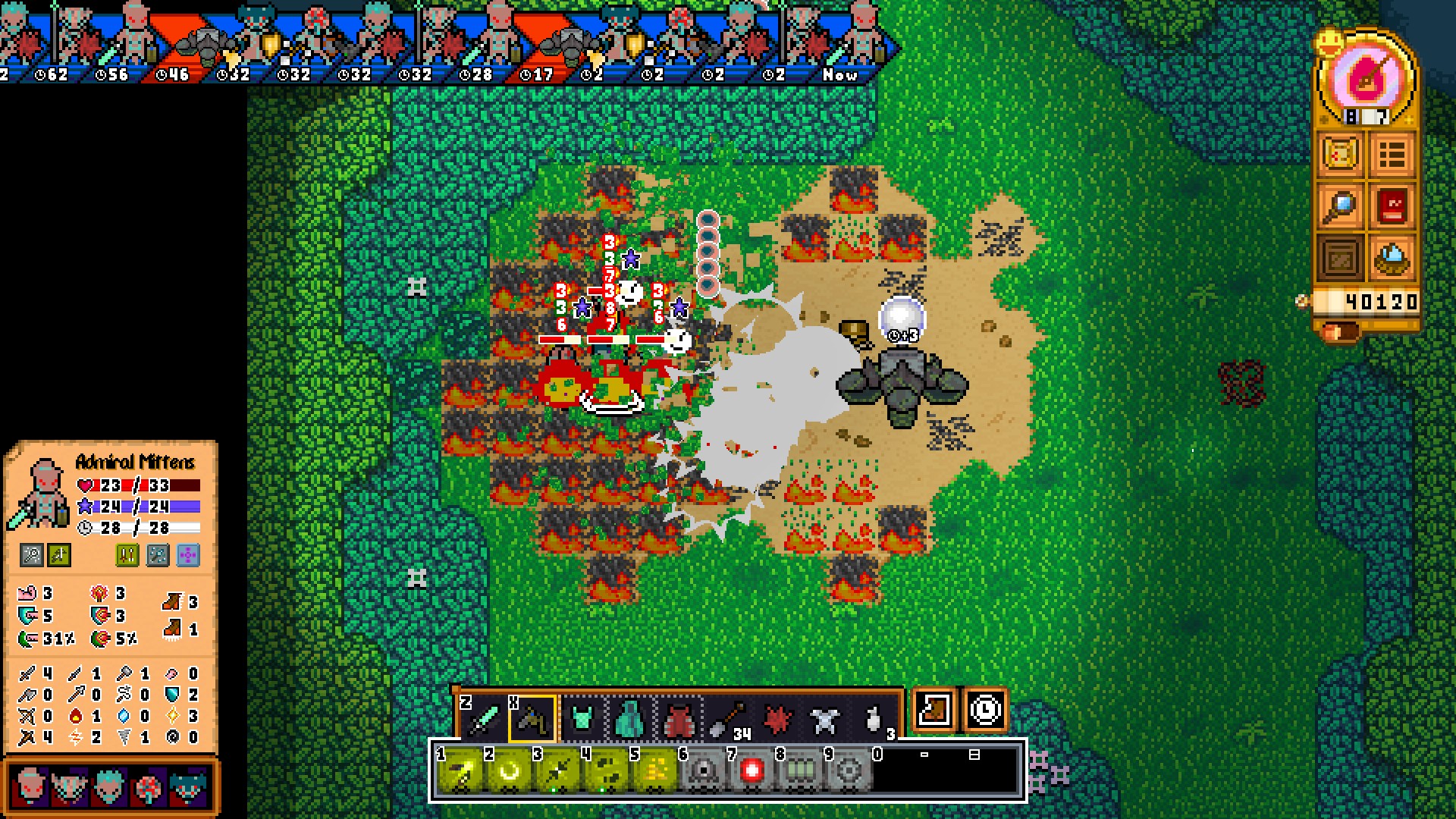
Something of note is that the AI is very averse to standing on any tiles that are part of an area of effect that has a delay on the time tracker on the top of the screen. This is particularly impactful on the Mechanist class, whose main trick is dropping down a turret, which shoots along a straight line. Even enemies that should be dumb, like worms, will avoid the attack area. That said, just because it rarely deals damage doesn’t mean that the turrets aren’t valuable, as denying the enemy the ability to stand in much of the battlefield makes other area-of-effect attacks much easier to line up as the enemy naturally lines up to squeeze into the choke points you create.
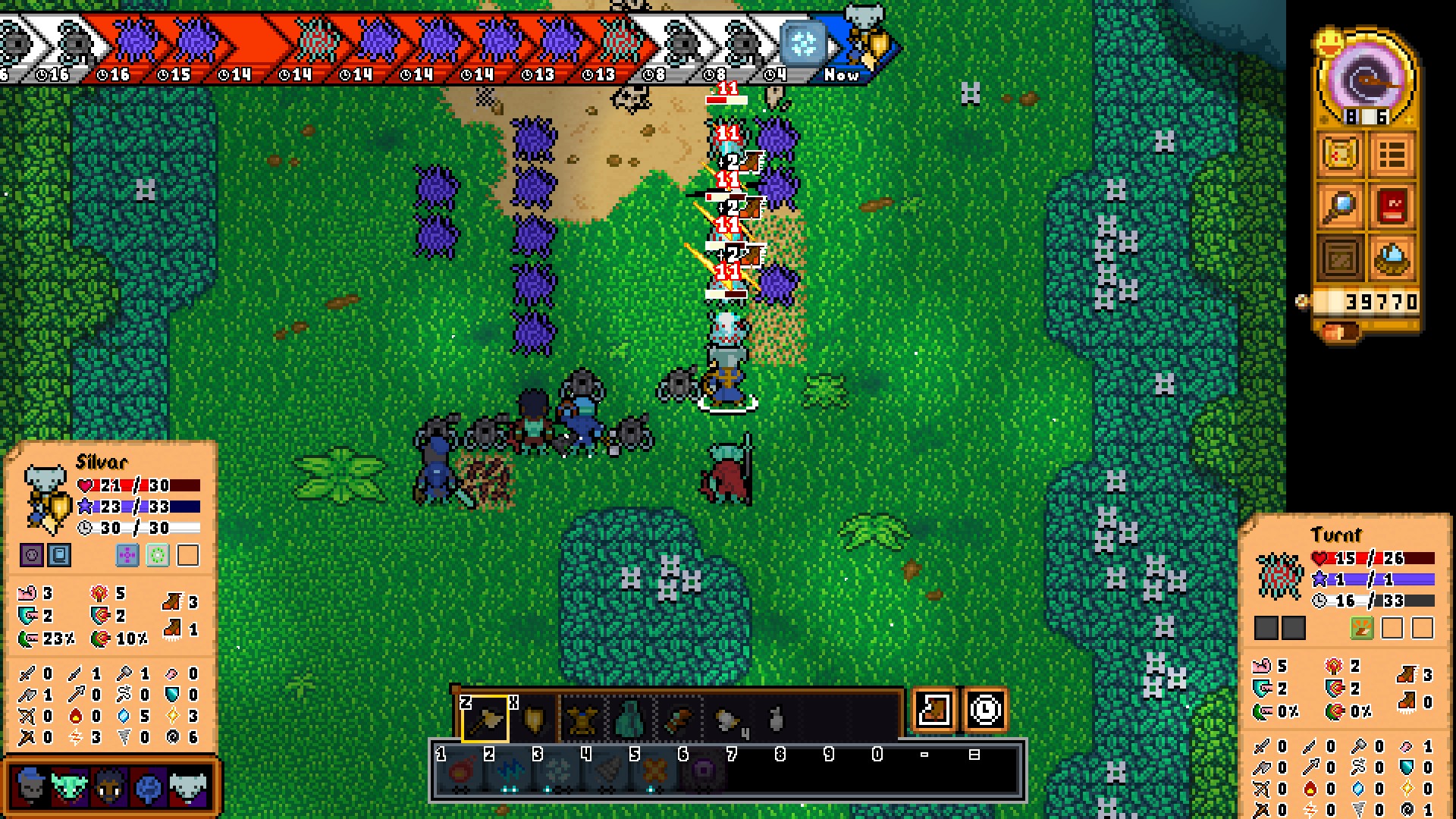
In boarding actions, the deck starts mostly clear but for some odd water barrels. Shooting the barrels will spread water puddles around, inflicting “wet” status that makes creatures more vulnerable to lightning attacks. Conversely, heavy fire magic starts fires on ships that can spread and deal damage to the combatants caught in it. (Oddly, this doesn’t apply to the ship – in fact, after boarding is over, time stops on that ship until the next boarding maneuver, where the same crew are still poisoned, and the same fires are burning…)
Class Warfare
Horizon’s Gate’s class system is highly reminiscent of Final Fantasy Tactics, comes from the Voidspire Tactics days, and therefore has basically nothing to do with any of the naval aspects of the game besides boarding.
The game features 35 different classes, of which you have one primary class at a time in which you gain experience, which also grants bonuses to attack power, defense, evasion, or skills, plus a secondary class that simply gives you access to previously-unlocked active abilities. Gaining experience in a class lets you unlock new classes, although beyond the basic classes, all classes need trainers to unlock them, which directly encourages exploration, as they are mostly scattered about the many ports you visit, with advanced classes generally being in further-flung ports.
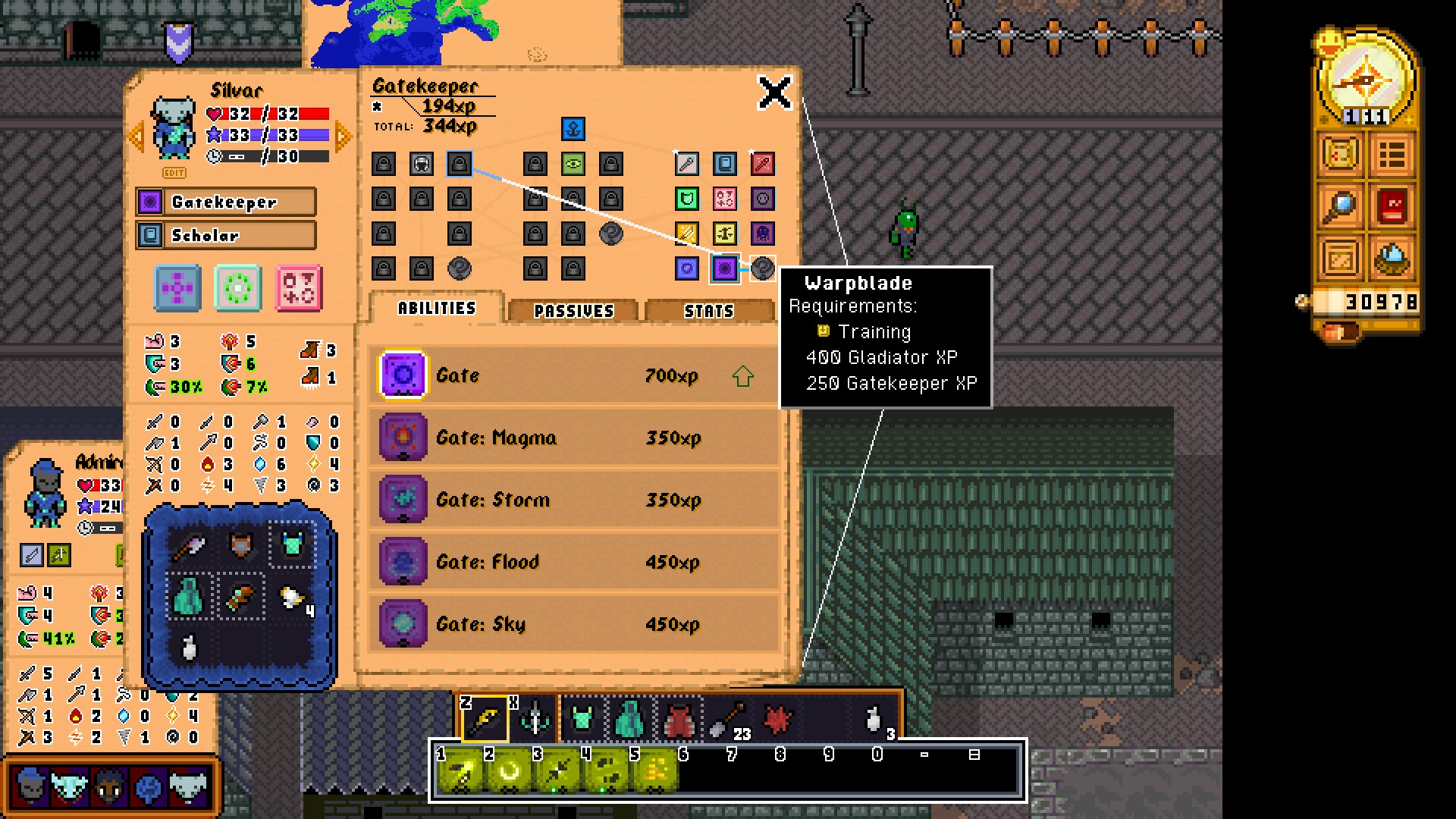
Classes are broken into the usual three broad categories of “fighter, rogue, and wizard” (clerics get no love), with subdivisions in different columns. For example, the right side of the rogue class group is taken up by archery-based classes. The left side of the wizard group generally contains the healing and buff side, while the middle is generally the elemental DPS side, and the right side has the dark “ruin” elemental magic focused upon debuffs and death magic.
Each class has five active abilities that can be purchased with experience points (no levels here), plus three to five passive skills that can fill up three passive slots independent of primary and secondary classes. (Counters are also considered “passive skills”, unlike Final Fantasy Tactics, and take up the same slots.) You can expand your active abilities with “ability crests” that are very rare prizes for certain things like being victorious in the arena or as items stocked rarely in some ports at 100% investment. These let you add a single active ability from a third and fourth class to your active ability roster to further round your class out.
Compared to Final Fantasy Tactics, this system is a quite bit more restrictive in that classes have less to offer, but it also has more classes to pick-and-choose from. I feel that mages suffer the most, as there are basically five classes that are all elemental damage-dealers, and the first one tends to be the best with advanced classes having casting times so long that they’re impractical to use as any target will simply walk outside the area of effect. Many of the better fighter classes have notable deficiencies in ranged combat or doing anything worthwhile at all if they are immobilized.
Many abilities are real stinkers, as well. While Final Fantasy Tactics Advance in particular was a game of crippling the enemy with status effects in the first round, then butchering the helpless sleeping suckers in the second, it’s often easier in Horizon’s Gate to just kill enemies in two hits with direct attacks outright, but even if you do want to inflict crippling status effects, many of them come on abilities that also deal damage (like advanced magic user classes that can immobilize or stun, or the Breaker class that can break an enemy’s sword and make it unusable, both of which deal half damage). Therefore, skills that make you use a turn just to lower enemy morale (for a -1 attack and defense malus) are just plain crappier alternatives to even the basic attack. Skills that take several turns to set up like the Bombardier’s bombs are only useful if you can set it up before combat starts, which make them useless in boarding actions.
Finally, you can also raise only a few of the character’s basic stats with class “stars” that are awarded per-class per 250 XP you gain in that class. Namely, HP and MP are raised this way one point at a time, and past the first couple points you buy, it costs more and more stars. You can also buy weapon and element skills this way, and they increase in price even more rapidly, with the price going 1, 2, 3, 5, 8, 11, 15, etc. Each rank of a weapon skill increases damage by 1 and accuracy by a whole 1% chance to hit. Woo. Classes are also restricted in what their stars can buy. Scholars (the basic mage class) can only raise MP and magic skills (and not Ruin magic), without even being able to raise HP without changing classes. Sharpshooters can only raise bow, crossbow, and jumping distance. Many basic features like defense cannot be raised at all through levels, making races that get a bonus to them much more valuable.
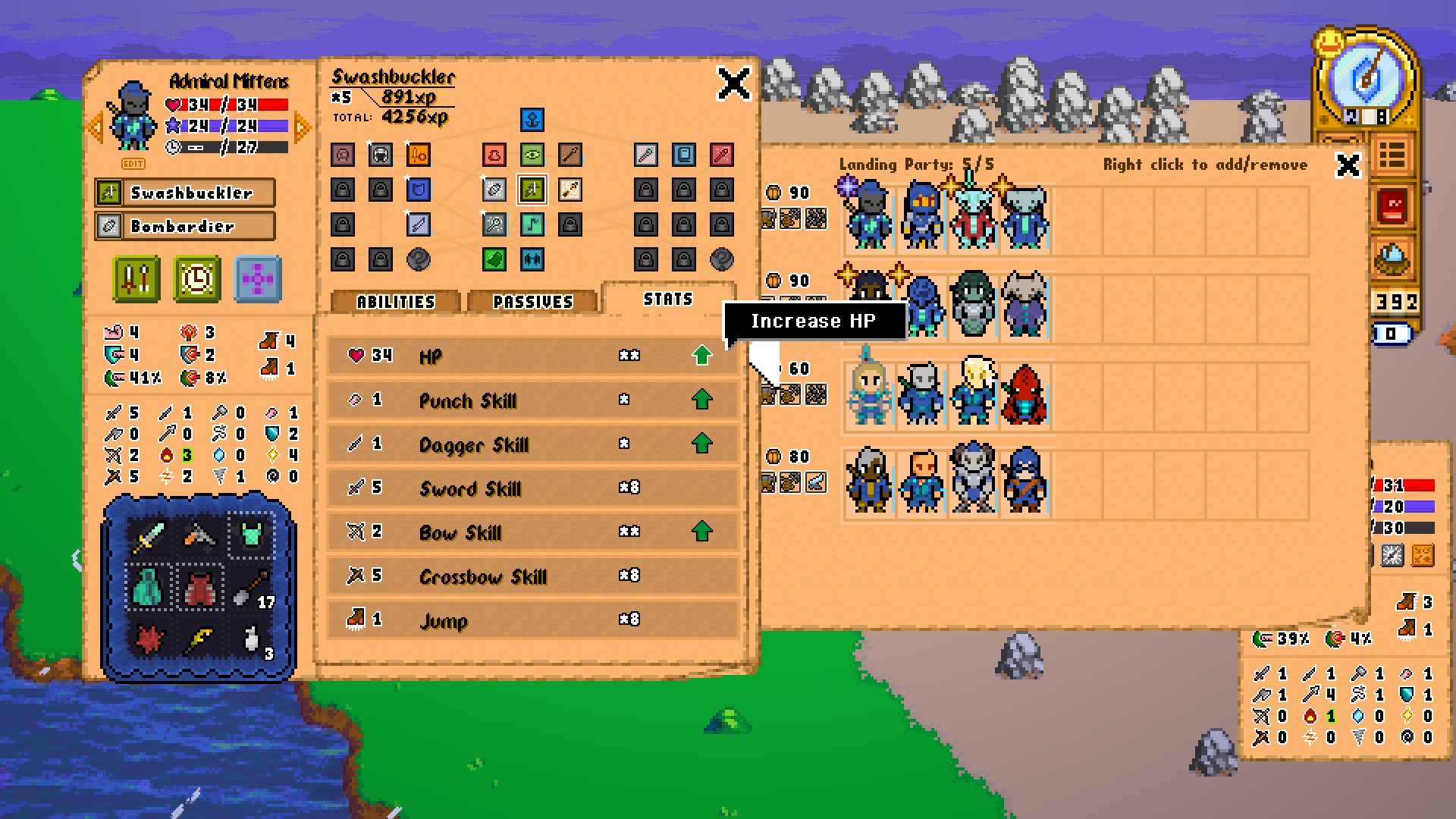
Due to the rising cost of bumping up even HP, your characters will tend towards having stats not terribly better than they started out with or compared to other crew members that aren’t in your main landing party even late into the game. A basic character has 30 HP, 20 MP, and 1 point in a smattering of weapon or magic skills, and even my best warriors are only up to 8 ranks in a skill and 38 hit points.
Story and World
The game starts with your new character apparently a commodore of the Domino navy in a storm that is quickly revealed to be a magical one created by surprisingly advanced technology held by pirates that hint you were set up.
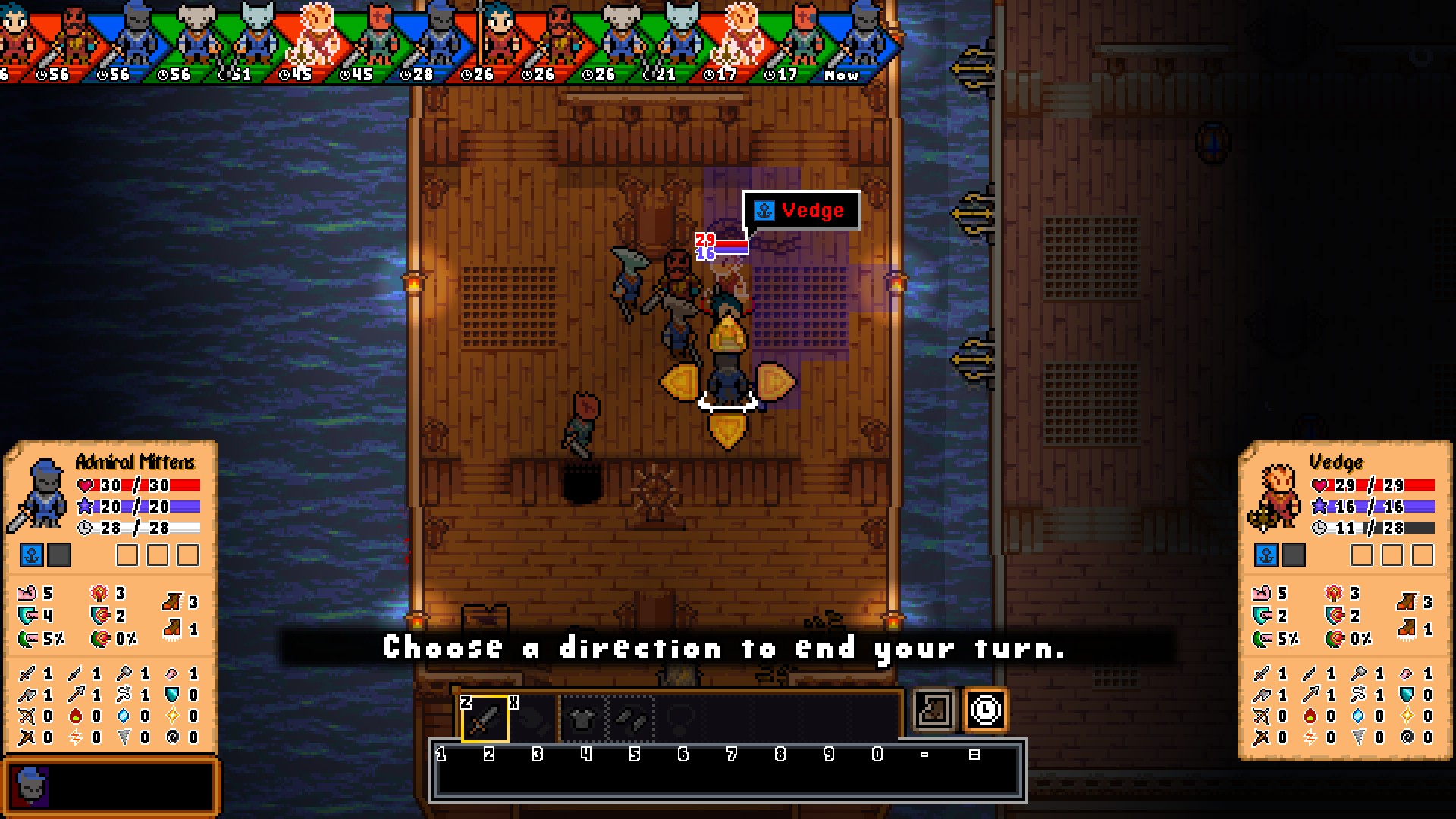
Before the intro is over, it’s revealed that someone high up in Domino betrayed you for some reason, so you’re on your own to ally with one of the three other major world powers. Then, the two characters that had the most speaking lines with you, including the first mate character who would have your back through thick and thin decide to go their own way. This leaves you with only Reeve, whose role on the ship is kind of not well-explained and whom I had thought, considering her reservations in believing that Domino backstabbed you all, might turn on the group, only to find she’s the one who’s meant to be your primary companion and exposition dumper.
Not that there’s much exposition to dump, mind you. Reeve makes a comment about many of the ports the first time you walk into them, but the world is sorely lacking in worldbuilding lore for one that is filled with so many fantasy creatures.
It is mentioned that the faceless, featureless race called Rasmen wear masks to fit in because their faceless nature makes them strange and alien to others, but that seems odd considering that they’re seemingly the most populous race in the game and should therefore set what is “normal”. Most races have at most three lines in a journal entry about them to give background, and much of that is physical description, although some text about how this one or another race is discriminated against is… just not present in the actual gameplay.
Essentially, the game is an open sandbox with a few small linear stories in the way of questlines sprinkled very far apart (like an early quest involving miners going missing, hiring you to clear it, and finding monsters in the mine…), but nothing explains what this world is. Maybe I just have to play Voidspire Tactics to find out, but if this is the way the storytelling works there, too, I don’t think that would give many any insights, either.
What this game really needs is some sort of Elder Scrolls or Mass Effect-style Journal entries that can go into the long-winded lore dumps of everything you’re supposed to know about the world, because it feels like walking into a conversation that’s been going on for hours using terms you only vaguely understand reaching conclusions you don’t get. When I go to Crubtown, for example, Reeve is nervous because she’s been on crub raiding parties, and it’s mentioned that most crub are barbarians that attack other races, and the crub in town say not to compare them to the barbarian ones… but the only crub I’ve ever seen are the peaceful crub, so why would I hold a grudge against them?!
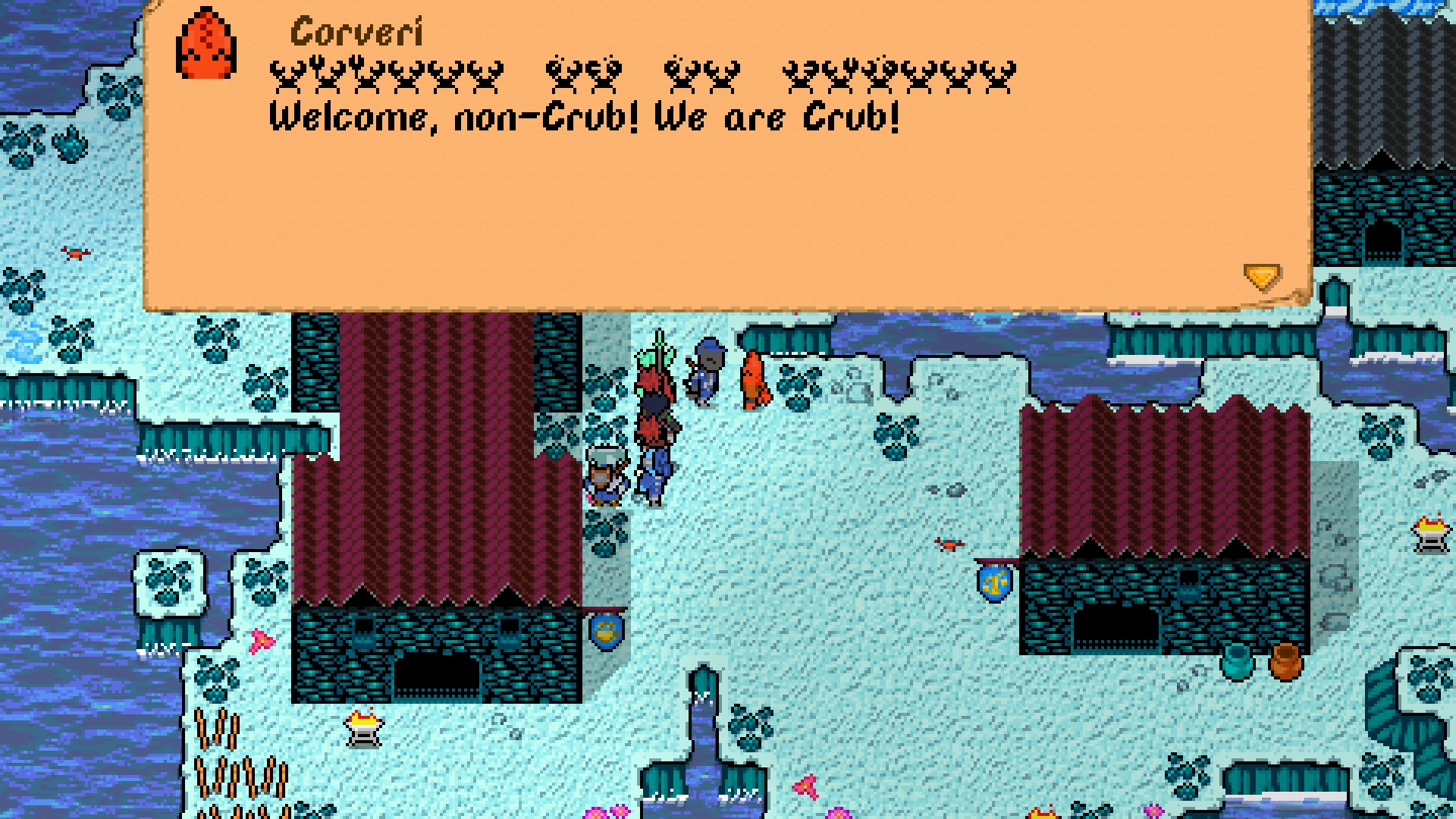
Likewise, there’s hints that Jasce, the self-proclaimed “living god” and God-Emperor of Jascia is a fake… but he doesn’t really do anything, and neither do the other factions, so there’s no particular reason for me to side with one over the other besides what ships they offer you as rewards for high favor.
Story isn’t necessary in a game like this (games like Patrician have basically none, anyway), but when games are set in the real world the way that Patrician or New Horizons were, I could just use basic knowledge of history to understand why King Henry VIII would hire Otto to be a privateer that targets the Spanish building up to the eventual goal of directly challenging the Spanish Armada. Eral, meanwhile, is a total blank slate to someone who came in on this game, and there’s absolutely no context for any of the events you’re seeing. You sail from one place to another, land on groves or caves because they are marked as points of interest, and then kill all the natives and loot their valuables like proper Conquistadors before going off to do it somewhere else because… it’s in the game, and it’s content. What, don’t like it? Well go back to trading or something, then.
Your ultimate goal is to get revenge on the pirate that sank your first ship, but I’m not that mad at this guy because I have no investment in Domino since I literally never even saw the place before I was forced to be exiled from it forever, and he was acting on orders from some other guy, anyway.
Story is therefore a massive hole in what this game has to offer, as there are few games that I actively wish would dump more lore on me. The game is just so lacking in context that it drains many of your choices of their weight.
Interface and Options
Hooray, Rad Codex offers full rebindable keys, including full controller support with rebindable keys for the controller, as well! Dear Rad Codex, please instruct the other indie devs whose games I’ve been reviewing how to accomplish this most basic and mandatory features for player accessibility.
Speaking of accessibility options, the game also has a color-blind mode, a dyslexia-friendly font mode, and a flashing-reducing option for people prone to epilepsy.
The game comes with three separate categories for difficulty, with combat difficulty (plus a “how long does the AI get to think about its turns”), exploration difficulty, and where you can save, with “hardcore” meaning you can only save in ports (which means failing a battle in a cave forces reloading a save back in port several days of sailing away from that cave). In the hardest exploration difficulty, there’s no icon on your map, so you have to judge your location based upon geographical features!

The game’s default controls still use the ergonomically-unfriendly system of needing to press the likes of “M” to look at your map, even though it’s a rather vital button to have handy, and the game is much better played by mouse, but it’s not hard to rebind keys to find a better system. (I dumped the F1-F5 keys being used for character selection, and just used next/previous character buttons mapped to V and C, respectively, then used F2 for map.)
I also tried using my Steam controller to play, which works decently with the default control scheme. However, I eventually wound up making a hybrid system so I could use the controller with my left hand and mouse with my right. Unorthodox, but I find it the most comfortable to play while reclining.
The only problems I have with the general interface are that the game relies upon a lot of pop-ups. The map, for example, would be much better stuck in the corner always up while sailing, since you have no way of knowing which small tributary to sail up to get to your destination without it open. You can scroll up on the map to zoom in and make the map take up a larger portion of the screen, but the map is placed over the screen where ships or monsters may appear, and the game isn’t paused while it’s open! Also, if you push the map up to the top corner of the screen, when you go into a town, the map may change to a town map which is smaller than the world map and be completely off the screen, so you can’t drag it down to see it. Even closing and reopening the map leaves it off-screen and inaccessible.
There’s also a similar problem with some menus only working with other menus open, and them fighting for which is on top. Adding cannons to ships, for example, takes opening the inventory menu and the fleet menu to drag cannons in the inventory onto ships. Both these menus take 2/3rds of the screen width on a standard 1080p display. Worse, you can also pick up boxes or satchels that expand your inventory by taking only one inventory slot but having a 3×3 to 5×5 grid inside them, but they’re all pop-ups, and you can’t differentiate one box from another box in your inventory without opening up bunches of pop-up box contents. Dragging an item from inventory into one also causes each menu you drag past to leap to the front, making shoving pop-up windows around a constant chore.
Graphics and Sound
Graphically, the game looks like a Super Nintendo game. (I actually think many SNES games looked better, although the PC version of New Horizons in my memory was better than the SNES version.) The thick black outlines tend to mean that there’s less detail in character sprites, and without close-up portraits, it’s hard to guess what many of these strange races are actually supposed to look like, especially the ones seemingly like Stellaris aliens with four eyes.
Sound-wise, the game has a soundtrack that isn’t quite chiptunes, but would feel right at home on the SNES, as well. Music changes as you cross latitudinal lines, with a vaguely Arabic tone in the southern desert areas, and a more melancholy tone in the icy north. Combat uses a tune that seems to fit an upbeat sea shanty. The only problem is it plays that one tune for every sea battle, which can get quite repetitive with a 100+ hour game. Eventually, you’ll want to switch to your own music.
Modding
Finally, it’s worth noting that the game is open to modding with a Steam Workshop. Few mods are on the page as of writing this, but one really interesting one adds farming to the game to make it even more Stardew Valley-like. (It uses a set of publicly-available pixel art crop art that matches the art style of the game surprisingly well.) The simple fact that you can add even more genres in on top of this game kind of points to the possibilities of how much this game could be expanded with a dedicated modding community. Even if all they did is added more NPCs or dungeons to the world, it would still be a big boost to this game’s potential longevity.
Verdict
I love all the parts of this game and I love its gestalt whole even more, with the exception of the lacking story. Horizon’s Gate satisfies what is admittedly a small niche, but it does so quite well. It’s a game I definitely want to play further, even as I’ve explored most of what I think I’ll uncover. That said, it could still be built upon to provide a more in-depth trading system. Perhaps, while getting “inspired” by older games, Rad Codex will take inspiration from some of the older simulationist models in the Patrician games, as well, plus some of the worldbuilding of Kirkbride-era Elder Scrolls to make a really deep world, and it can gradually iterate into a truly perfect game.

